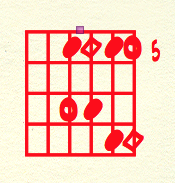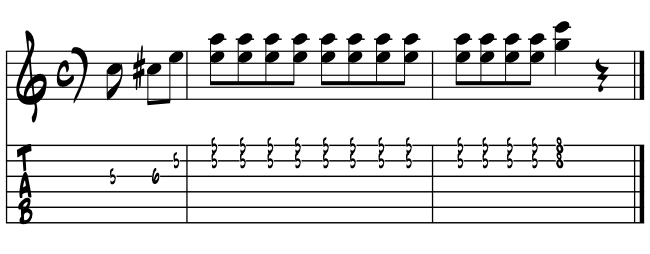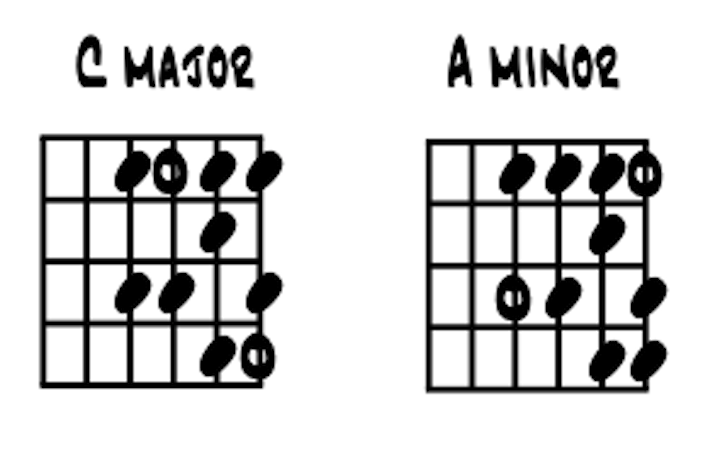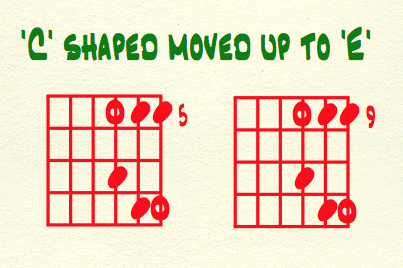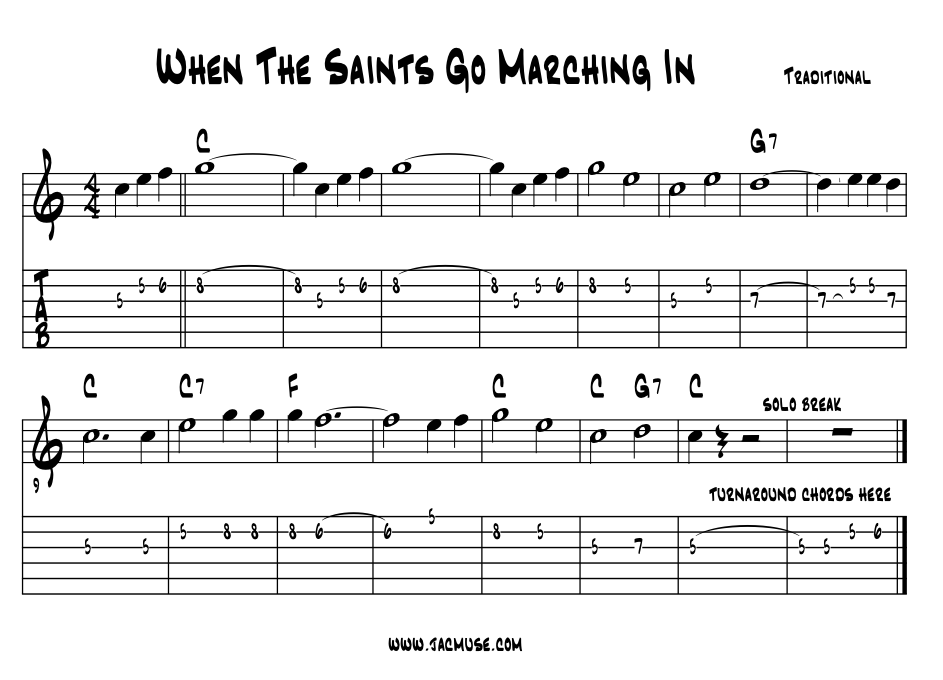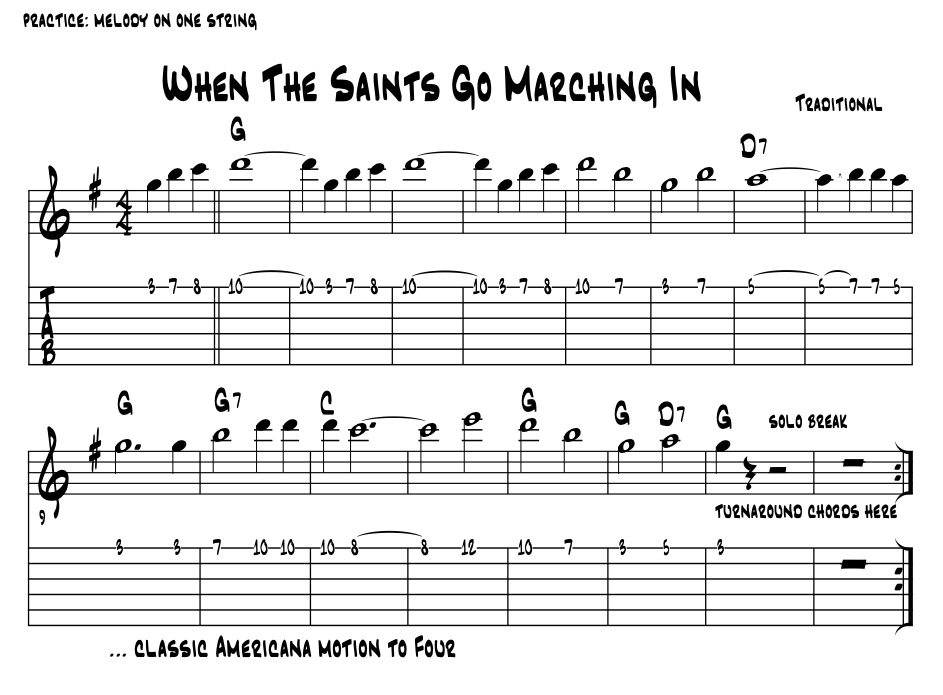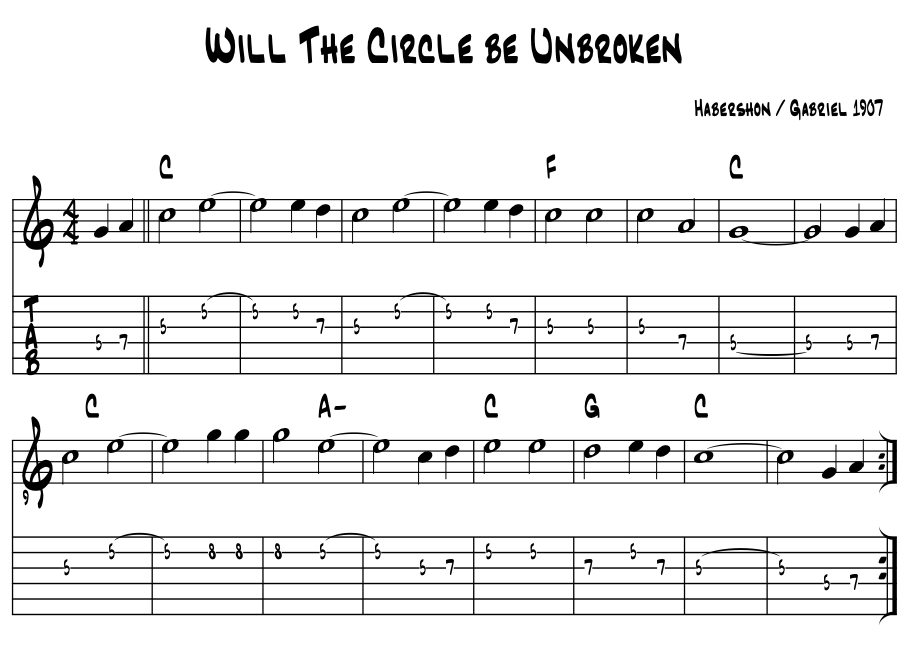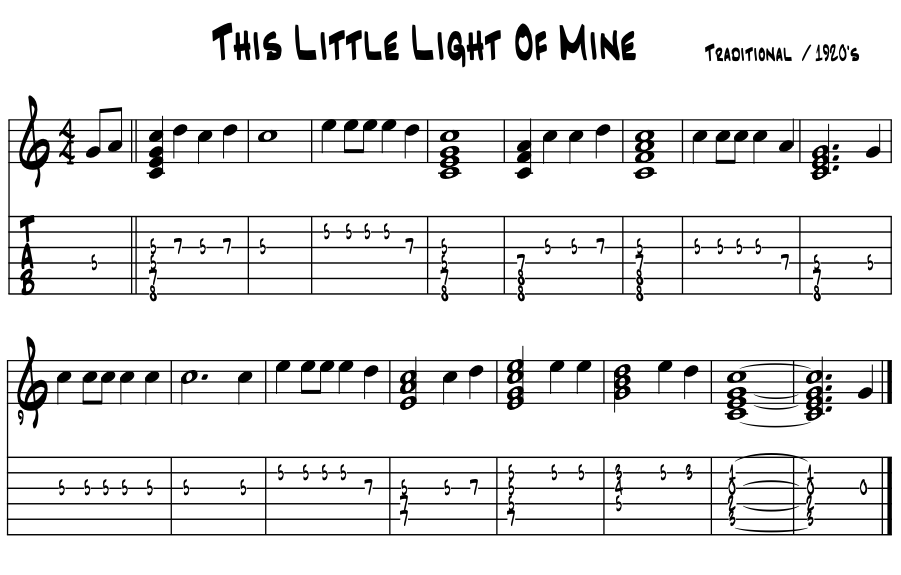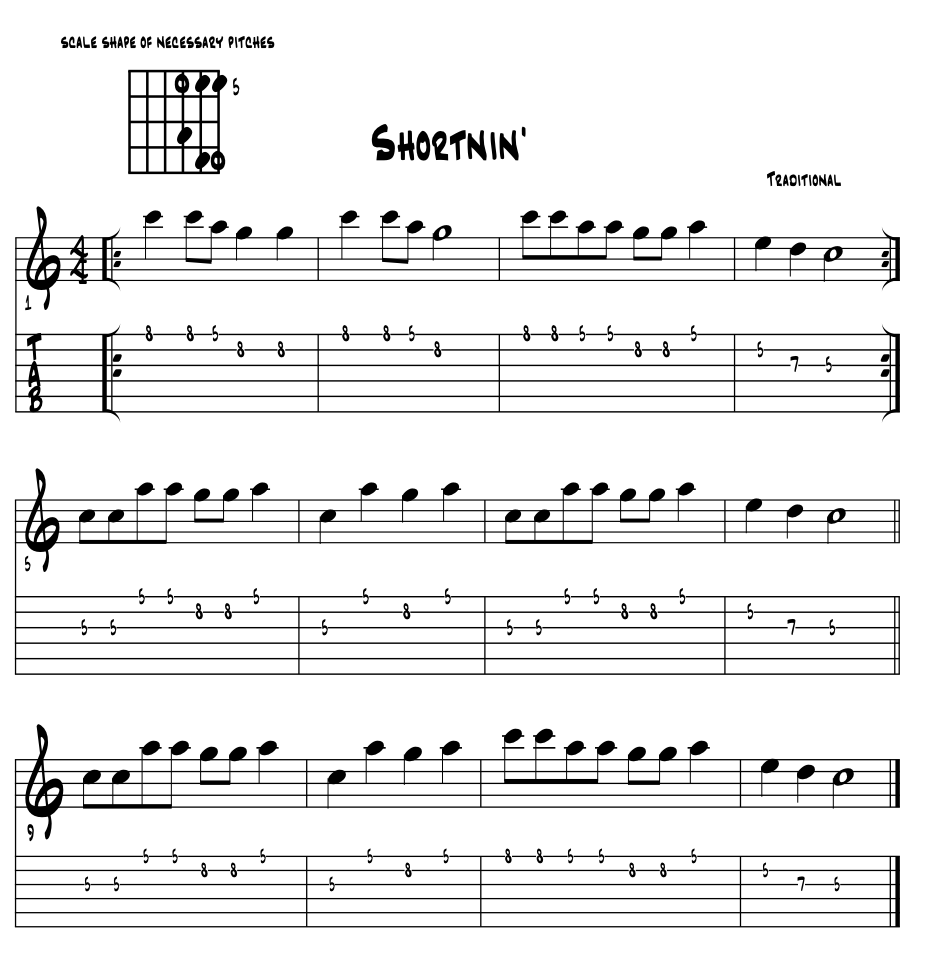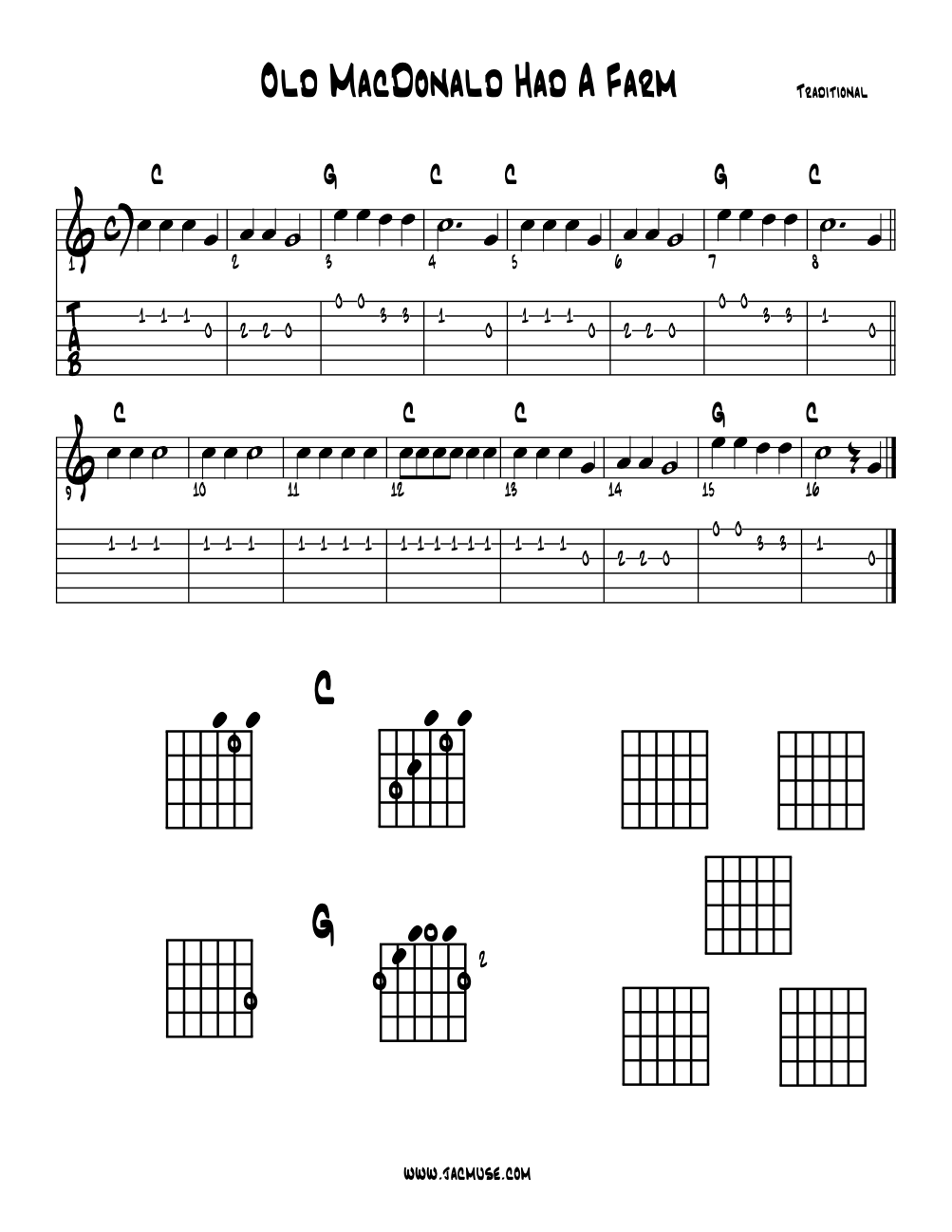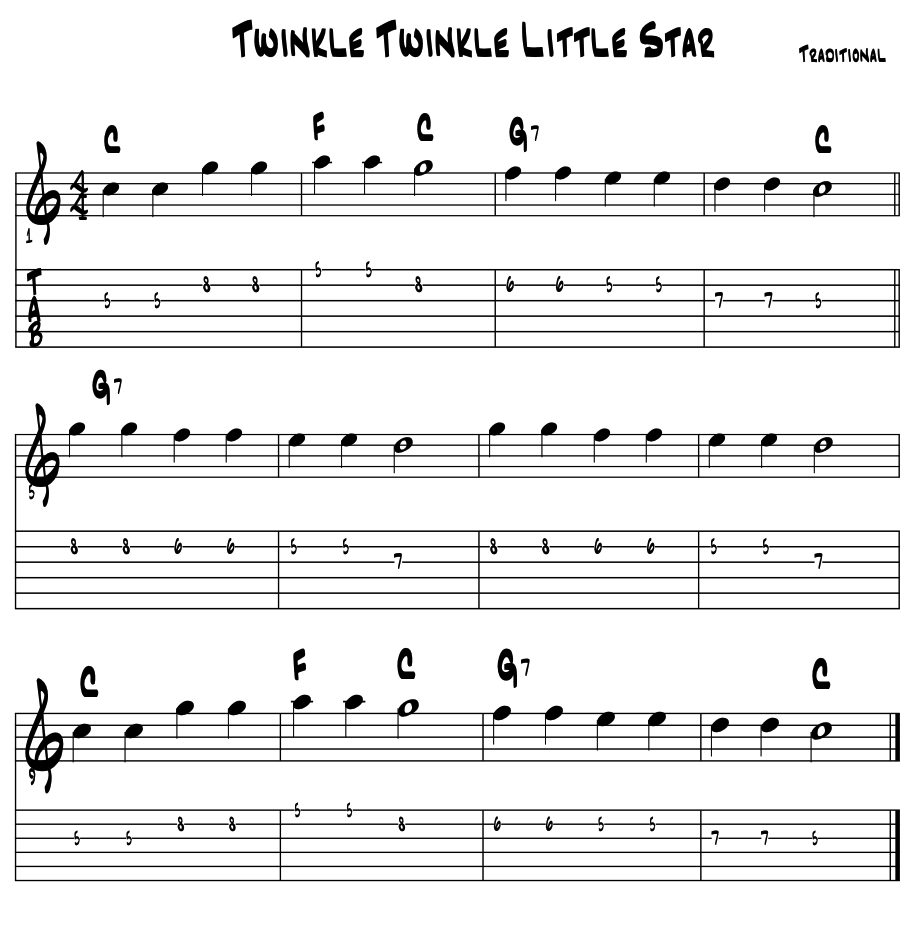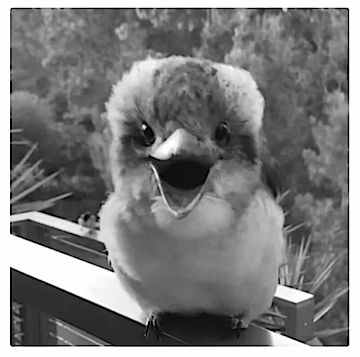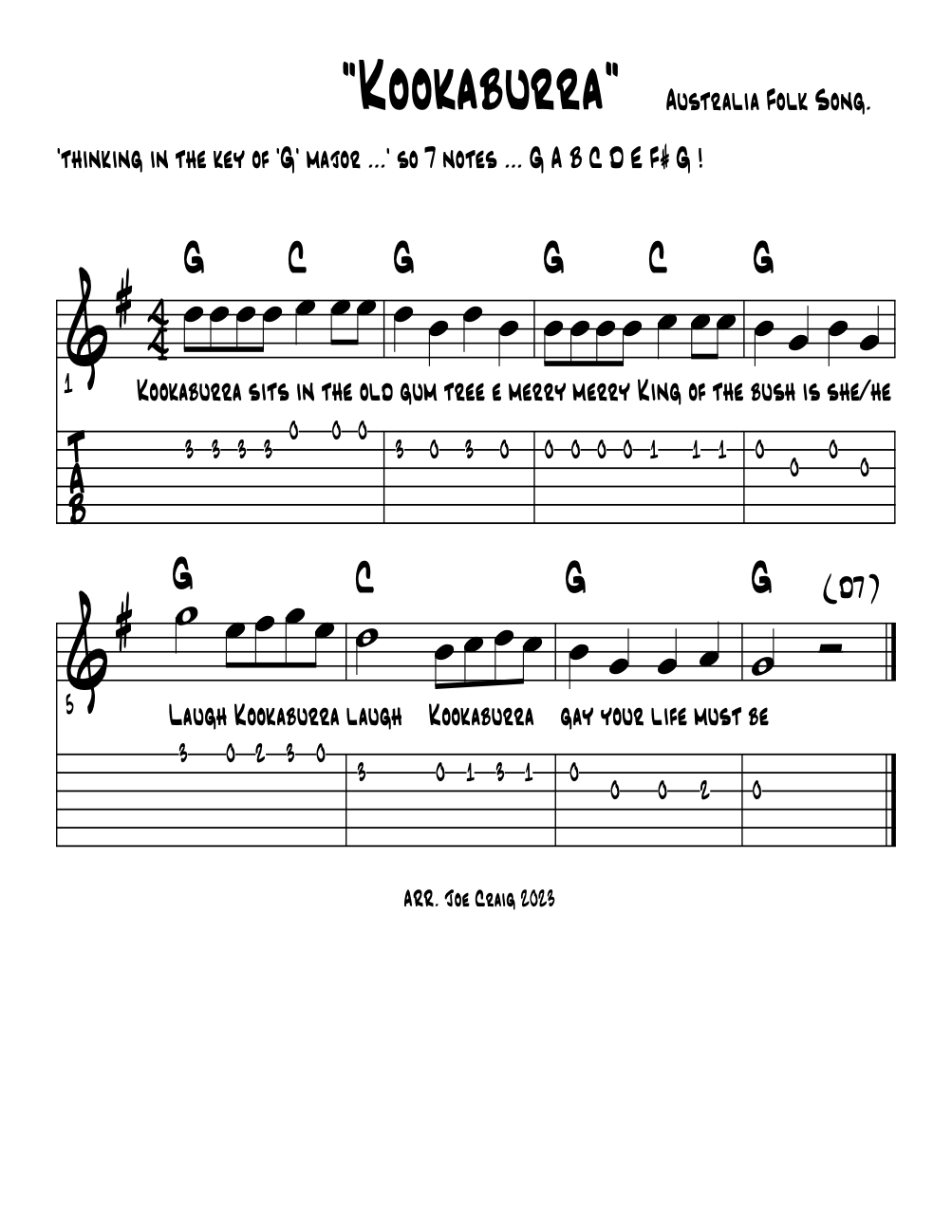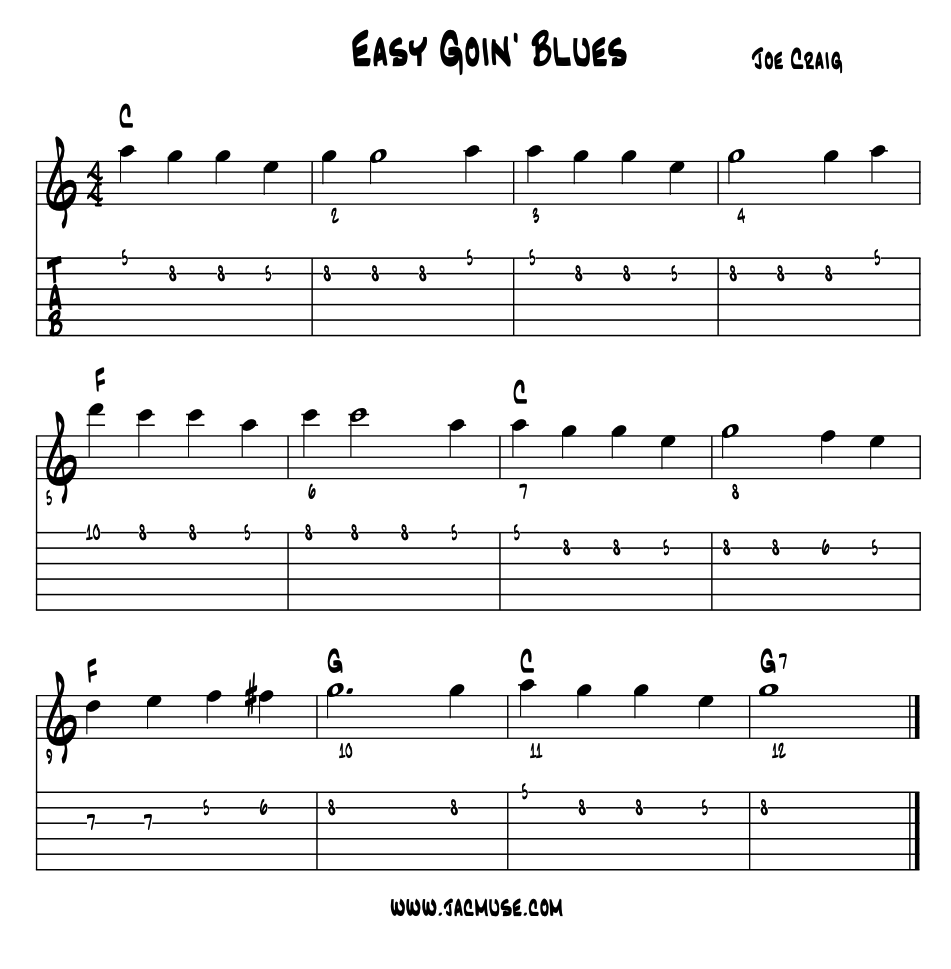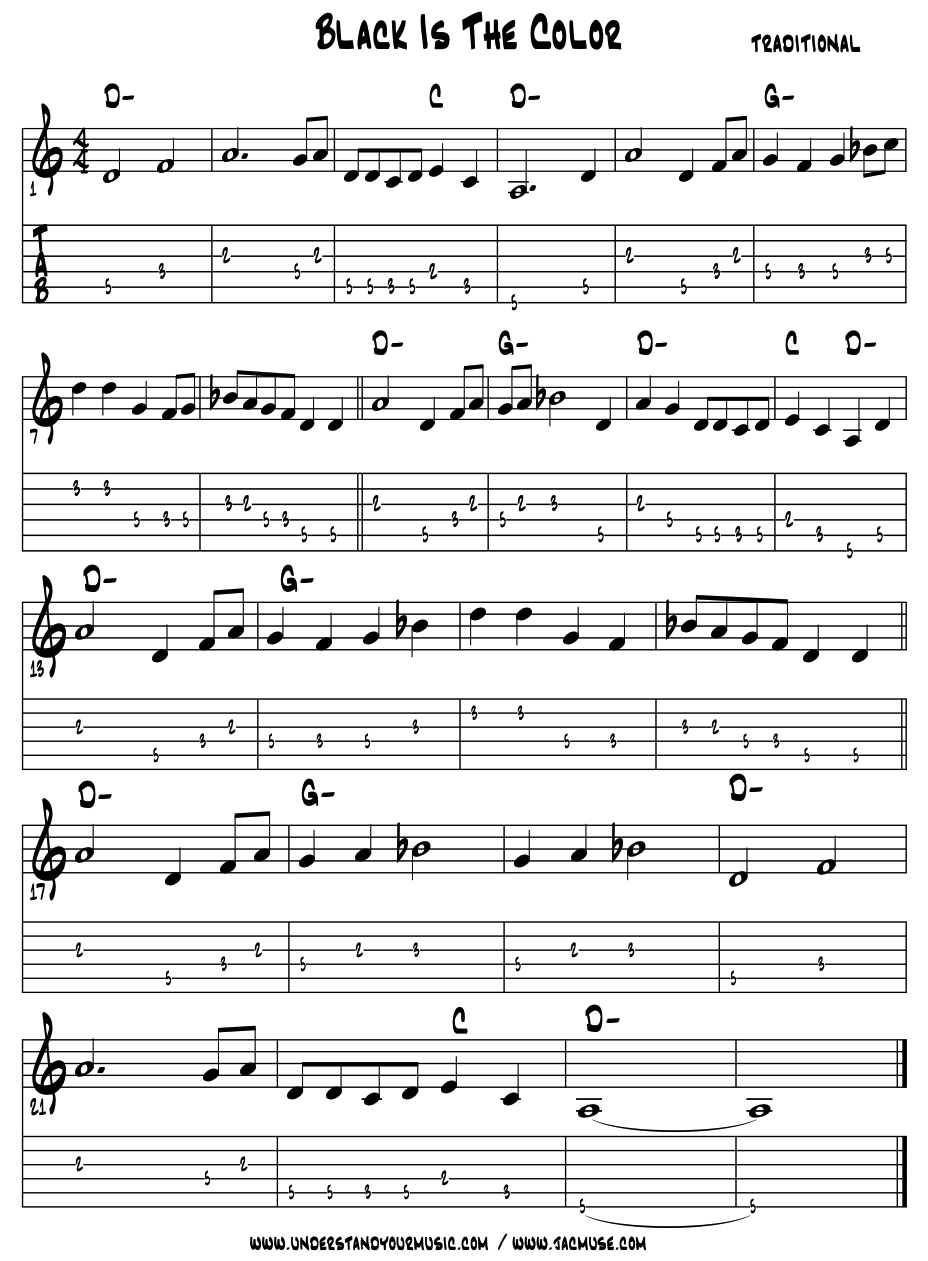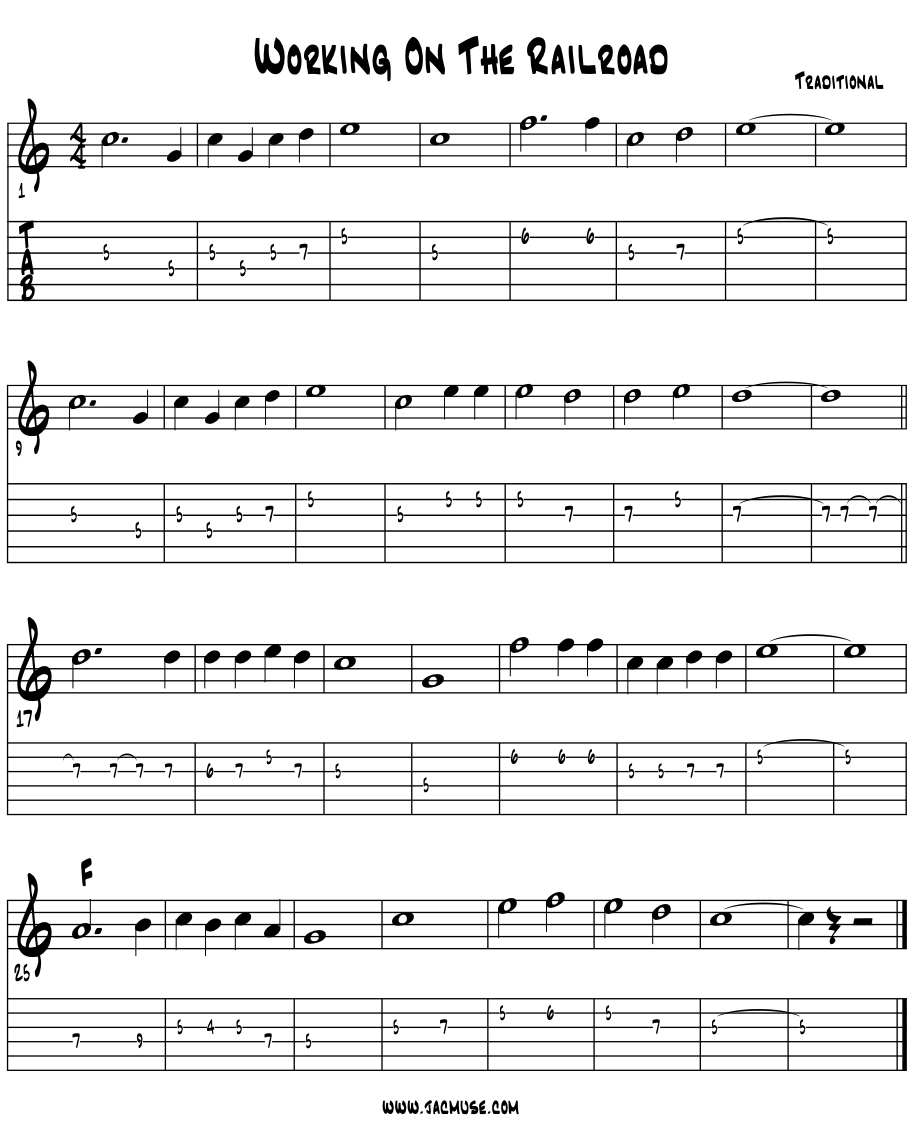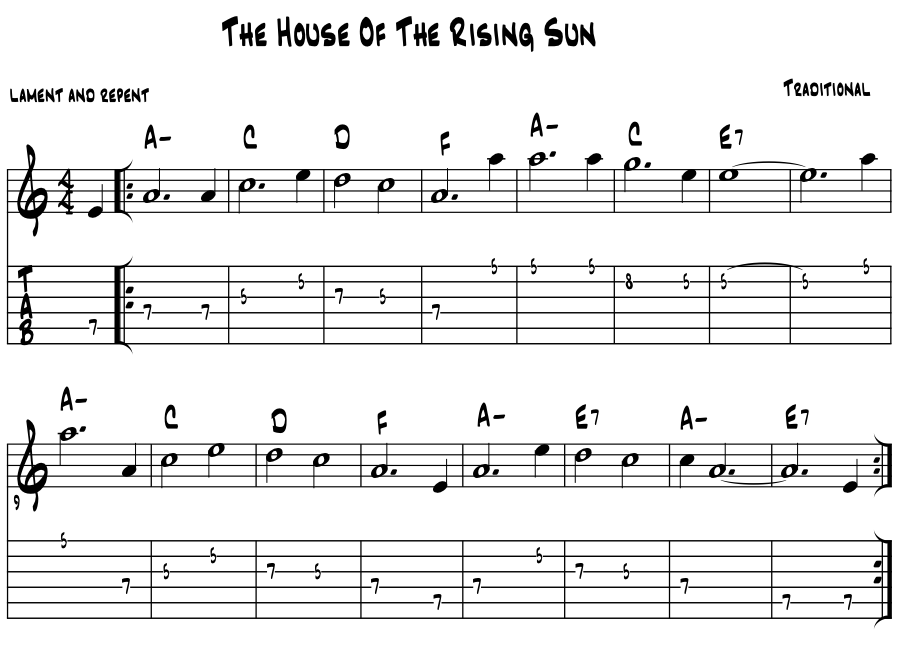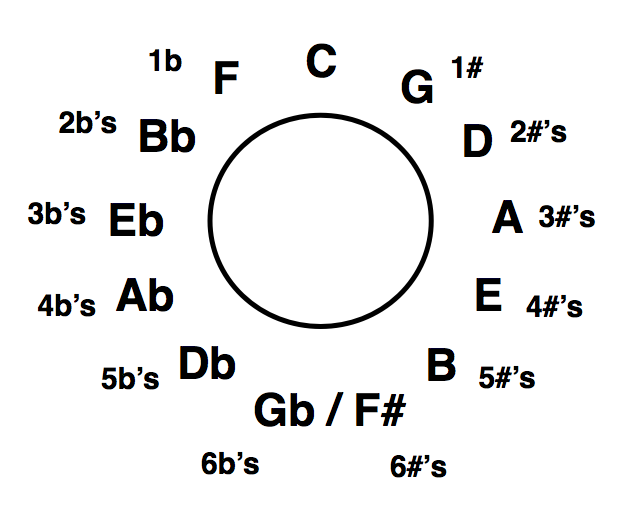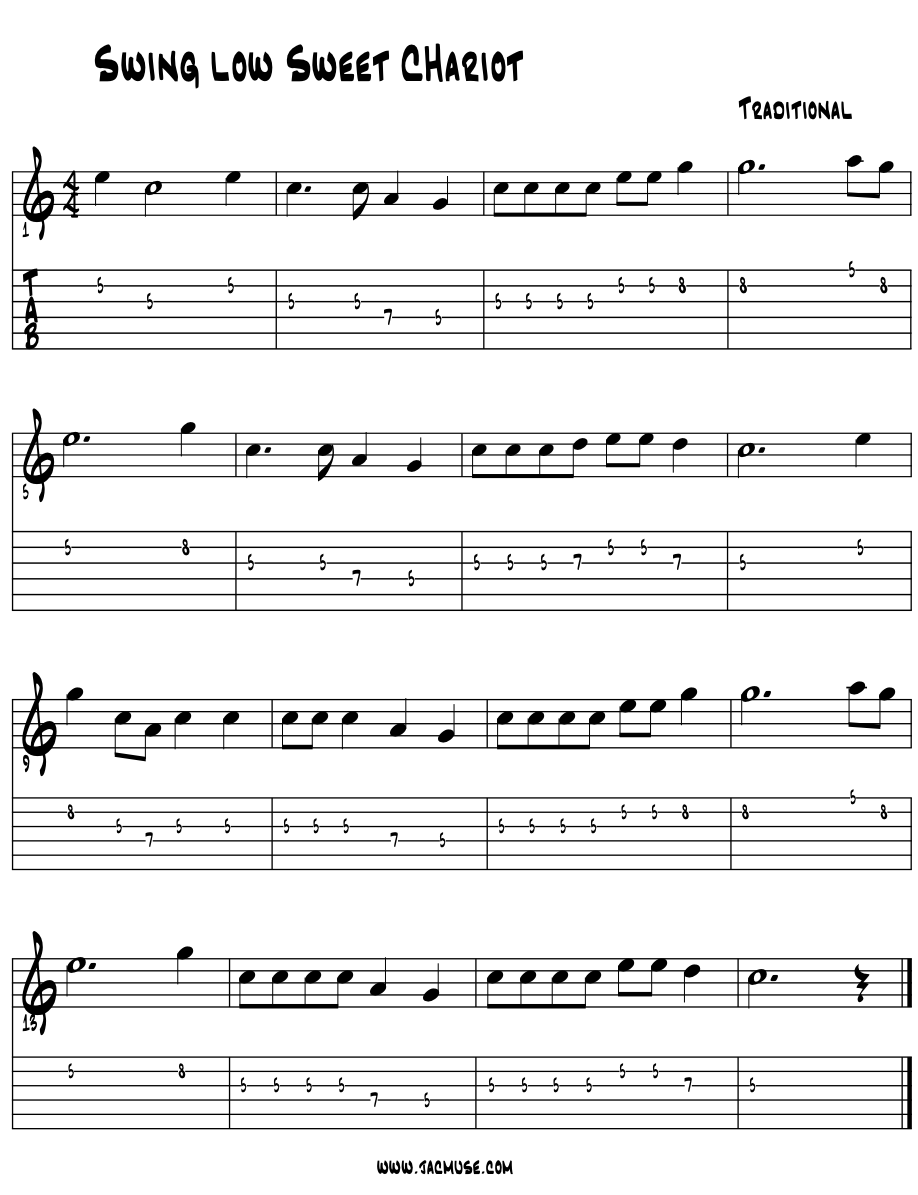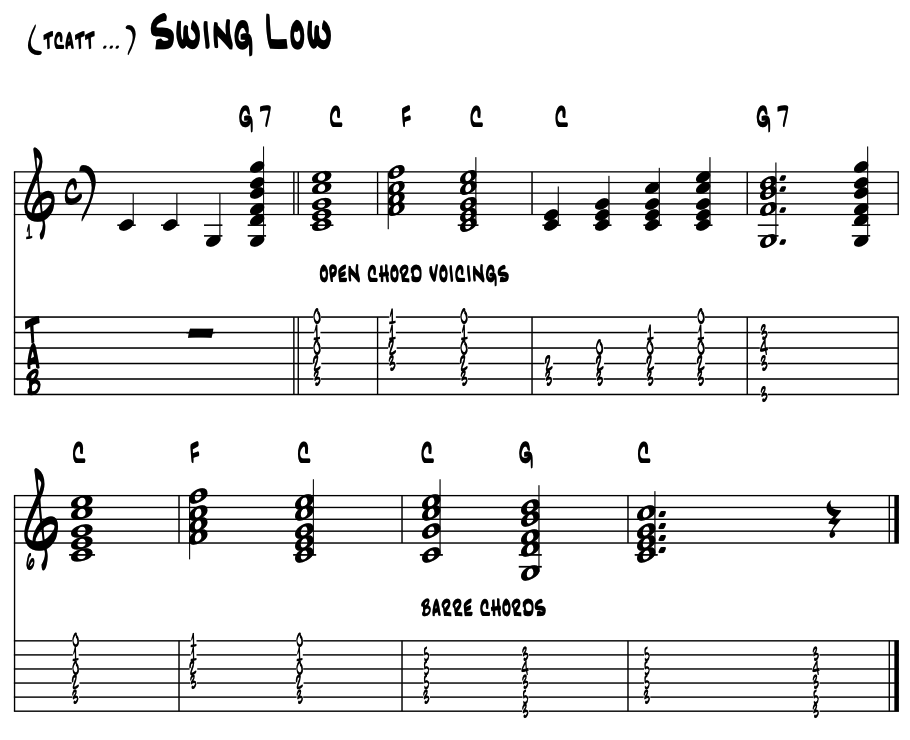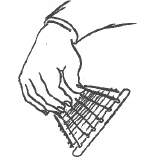~ 'everyone plays the melody :) ~
~ now rote energized, we all play the melody ~ ~ in one key for all instruments ~ ~ in one key with one shape for guitar ~ ~ in a lead sheet format ~ ... and we fear the melody no more :) . 'all our journeys have need of a first step' |
In a nutshell. It's been said by many now, all through the ages, that playing the melody of a song brings us a great joy by mastering the challenge of capturing a song's message through pitch and rhythm. As an ultimate way to organically express our own ideas, as we each accumulate the melodies we are drawn to, they begin to blend together; by use of the same key, or pitches, maybe a triad riff, a sequence of a few notes, a one of a kind rhythm or lick that helps a 'standard' be a standard. Over the years and on through the decades of our careers, this library of melodies becomes the 'well' of vocabulary for our own melodies, especially in our improvisations. And in drawing for the well our improvs sound like melodies. And through all of our Americana styles, that leave some 'room to make it up', these improvised melodies during performance can express an artist's passion in that moment, for all to behold, to testify. And for all that listen ... 'that's music to our ears.' |
In a nutshell. 'Everyone gets to play the melody here, and lots of them too ! It just takes one to spark the inter-connectional physical magics of interacting with any musical instrument.' And once these sparks make these connections, even just once, we'll always know how to find our way back to the magics of playing melody. Big joys playing melody, as our music soars through time we get to sound them out, the pitches, one by one, to tell the song's story just the way we want to, 'cause we're playing the melody ! On whatever instrument you have at hand, finding the melody makes us storytellers. Since all of these songs here have lyrics, we all get to be vocalists too. And since the 'sing and play' is so pure rote Americana, this learning too is built right into playing the melody. Match up what we can imagine, and sing, and play on our instrument, and align our hearts, head and hands forevermore. |
With words or sans, the physical joy of playing melodies and even filling a dancefloor ... is just a something everyone should get to do at least a time or two. And depending on a lot of spokes, even if we're currently the bass drum player in the marching band, we know that's where all our Americana '2 and 4' started for real, and ... in our studies here, everyone gets to play the melody. |
Just one. While hopefully there are a few melodies that click, it really only takes one song, one melody line, to begin to puzzle the pieces of how to 'play by ear' into place within each of us. One melody of pitches to get all our art / music making senses all linked together to express the art in our hearts. With one melody solid and deep, more good lines and melodies will surely follow. But we gotta have one. |
So the strengthening of this emotional to physical is the goal here. It's understanding and capturing the magical story in a melody that we seek to master. So we start simply to have some fun. And if we can connect all up with just one or a couple of pitches, we've then anatomically begun to connect 'play by ear' dots, and knowing there's only 12 dots, and that most melodies only need five or six, maybe seven. The blues? Two or three pitches can do it. U've an artistic signature? Yep. |
Learn to read / symbol recognition. Learning to read standard music notation today from scratch is simply about wanting to do it, then doing it. Just do it? Yep. We strengthen up our abilities to read music by doing. The melodies included here are an easy way to begin to read. Reading music is like reading letters, we learn to recognize patterns. We want to keep our eyes moving because that's what music does, it flows along steady in time, we don't stop. Regardless of results, train yourself to keep your eyes moving, rote learning the note symbols will eventually get things to fall into place. Try playing a melody by ear, then reading it. So if you want to read music, start as soon as you can, knowing you'll get better by working at it. It's not that hard to read music and our notation has been around a long, long time. The bugs are worked out of it :) Then there's the blues, even a further nuance of the symbols. And as guitarists, our written part is also commonly chord symbols. Chord charts are fun to read. And notated with chords and the written melody line? This we term a 'leadsheet.' For guitar. The cool thing with guitar is how certain sorts of licks have to happen an exact way to sound legit. Take the cliche rockin' double stop, for example.
Cool ? Yea, gots to double stop it up on the top two strings, bring some twang to juice it up :) In most guitar music these days, the 'tab' helped put the pitches in place leaving the rhythm to notation and the ears. So read some every day you can, and like most things in life we strive to achieve, we'll get better by trying and not ever really giving up. Quitters rarely win or so it seems, and vast trove of written music that reading opens up can make it well worth the effort. |
Learn to improvise. Most of the melodies presented below are extracted from these two scale shapes in and around 5th position; so C major and 'A' minor. Look familiar? Cool or just learn them here if need be. As most of the songs which follow are in 'C' major and 'A' minor. Modally the same pitches, these near identical shapes merge into and come from the original one. Regardless, these two are a true super wonder for the modern guitarist. Example 1. |
Learn the words. Perhaps the easiest way to sound 'convincing' when playing real melodies is to simply sing the words of the song along with our interpretations of the melody. Want to bring more 'emotional' whatever to your thing, find the words of a song and use their emotional story / expression in your mind as you bring to life your instrumental expressions / version of the story being told. Tricky at first depending but way way way powerful once where all lashed up. |
Diatonic melodies. All of the melodies included here are for the most part completely diatonic to their key center. Only these pitches are used to create the melodies. There's a few exceptions of course, there always is, but diatonic rules the day with these lines. Hearing diatonic, thus when a pitch used is non-diatonic, is just part of the learning process here. |
One scale shape / 'C' in the middle / 'A' in the middle. Since most of the music included minimizes the sharps and flats in its notation, we hang around this 'C' in the middle note on our guitars a lot. Most of the melodies presented below are extracted from these two scale shapes in and around 5th position; so 'C major and A' minor. Look familiar? Cool or just learn them here if need be. As most of the songs which follow are in 'C' major and 'A' minor. Modally the same pitches, these near identical shapes merge into and come from the original one. Regardless, these two are a true super wonder for the modern guitarist. 'C' in the middle, 'A' in the middle :) Example 1. |
So find a line. So the following learning method is created by two main ingredients; our own personal music experiences and American melodies that have been around for a long while; the melodies that pass from generation to generation that carry forward the philosophical and historical Americana spirit within. |
Most of the following come from Let Music Ring, a music curriculum series that was used in America's public schools during the last century. So is this the classroom text used by dedicated teachers to instruct so many of our national music heroes? Yep them be the cats. So pick and click and off ya go ... just to pick and click and off ya go :) |
Shedding 101 for guitar, same scale shape moved up a couple of frets. So the basic dual weave here now goes kaboom for those who have the energy for the shedding. And while it's pretty straightforward to do chops wise, its pitch theory tangles a bit with sharps. So we rote learn the music first in 'C', so in notation there's no sharps or flats to confuse discussions of the pathways, then transpose it to 'E'. As this is a copy / paste motion on a regular guitar, it can happen very quickly. And once settled into the key of 'E', we then get the low open 'E' as a bass note to support our melodies etc. Thirdly, add in some clicks to complete a trifecta for modern guitar shedding of this "Essentials" method. Going up ... ! |
Got your ax ? Play the melody. Once a person told me that they left the school band, and when asked why they said, "I never got to play the melody." Bummer. Here's 50 + one melodies together to let your music / melody ring out, so pick one to play and learn its melody, work its phrasing to make it your own, then 'soar' your spirit loud and clear by sounding out a melody you know from the depths of your heart. These songs are all written out in 'C' major / 'A minor. So, learn a few melodies and their pitches may start to blend together. Then if you hear something along the way, try to play it and keep it all going, circle back and find the melody. It's easy once ya get the hang of it. As diatonic melodies are the rule here, they'll all blend together somehow, that's our own puzzle to solve ! |
|
our national anthem |
|
swing built right in with original 5 pitches |
|
among the first melodies for kids |
|
a joyous melody for all |
|
a beginning song that starts on Four |
|
a true Alaska story ... :) |
|
banjo tune / solid triad construction |
|
octave leap set the game in motion :) |
|
for kids / triadic, vanilla 12 bar blues |
|
top of the list everyone knows it / big 4 |
|
core minor colors / octave leap within |
|
one we really just gotta know |
|
title of song can cover all the words |
|
a beginning song for even eighths |
|
for kids / triadic, vanilla 12 bar blues |
|
for kids / big wide swing in octaves |
|
pure pure natural minor |
|
classic ballad and modulation to Six |
|
just the hook of the classical 'gallop' we love |
|
gospel fave and sweet chord melody |
|
big four drive w/ a nice hang on the dominant |
|
banjo tune / solid triad construction |
|
cliche hook of the classical 'gallop' we love |
|
gospel gem minor blue note featured |
|
just an essential melody for all |
|
pairing of major minor lines / big swing in 3 |
|
a true Alaska story ... :) |
|
all seven pitches w/ big swing built right within |
|
great story for voice |
|
alternating tonic and dominant at their best |
|
arpeggio major triads all the way |
|
a mosey in 3 down the avenue ... |
|
octave leap set the game in motion :) |
|
just a perfect lilt and balance of form |
|
big four swing in octaves |
|
early country tellin' a story gem |
|
big 4 quarter note swing |
|
for the wee one's always |
|
total standard for the pro leaning picker |
|
a perfect major 3rd / sus 4 motion |
|
way early jazzer with changes to play through ... |
|
among the first of a jazz 'standard' song ... |
|
pure major pentatonic, one for New Years Eve ... |
|
'up' bluegrass # sharpen 1/8th note chops |
|
one all Americana's should know by heart |
|
our national anthem |
"Learn the theme, then the variations." wiki ~ ancient wisdom :) |
Pitch letter names for treble clef. Here are the letter name pitches for the treble clef. Same clef and pitches now for a 1000 years or so. Learn them up here if need be. Example a. |
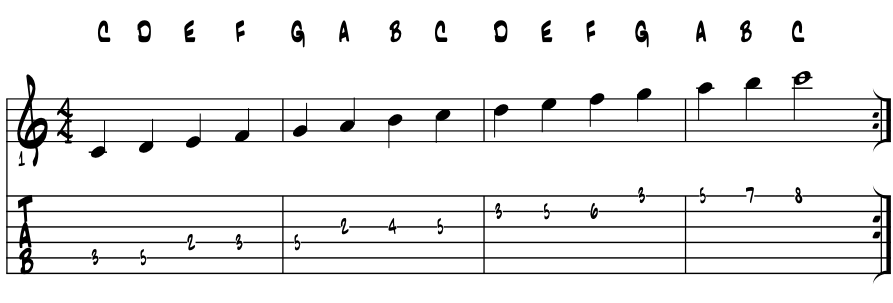 |
Sing the line and bring the swing ... :) Ya know this song yet ... ? Have it under your fingers and can sing the pitches /rhythms too ? Maybe even learn it here if need be for so much Americana vibes and musics can be learned in this one song and its lyrics. It goes all the way back and is still swings fine today. If you can find the swing in this melody (hint, it is nearly built right in :) then all the rest under your fingers will swing and groove a a bit Americana deeper too. We rote learn it for UYM / EMG as a first melody, in a major key, to begin to lock in pitches, shapes et all of the pure magics of the original pentatonic major color in 'C.' |
Sing and bring the swing ... 'when the ... "The Saints Go Marching In." Know this song? Have it under your fingers yet? Learn it here if need be. For so much Americana can be learned in this one song. It goes all the way back and is still swings fine today. If you can find the swing in this melody, and it is nearly built right in, then all under your fingers can swing a bit deeper. We rote learn it for UYM / EMG as a first melody, in a major key, to begin to lock in pitches. The pure pentatonic major in 'G.' :) |
|
| This melody is truly classic Americana. Been mostly associated as a jazz melody, we get an original source for the essential 'big 4', four quarter notes pounding out the beat for the parade band to step lively to. The swing is built right in. The swing is built right in. The swing is ... get this one melody to swing ... and a lot will fall into place there ever after :) Promise. |
| Recorded by dozens of top stars over the all decades, Louis Armstrong, who probably wrote it :), taught us how we all we might swing with his phrasing of this melody, and many many others, both with his horn and with his voice. 'Scat' singing he called it. So grab your horn and join along, and learn this lil' song by heart. |
|
| Once the pitches are in place, get Franz going, on 2 and 4 even, and find the pull of its swing, then your own way of timing the swing. The opening lick is an easy major triad sequence. First pitch? 'G' of course :) Hipsters will run it through the 12 major keys. Example 1. |
Here's the line and tab in 'G' major, getting all of the pitches onto the top string 'E.' This is a good way to get comfortable accurately moving up and down the neck with a nice melody to bring to life. It also gives us the top pitches of the five core scale shapes in 'G', among the guitars fave, 'built right in', key centers. Ex. 1a. |
Interesting eh? Bring some nuance to every pitch? Slide and slurring on some of the key notes? Cool with the motion to Four? Then right on and also know we're in Mr. Armstrong's key too, so in good company :) |
Method whole tamale. Crazy but beyond imagination, just turns out that if we shed 'Saint's in the above manner, from the exact same third fret position, we make this melody right off but in the different key centers on our six string, standard tuned guitar; top to bottom, high pitched 1 2 3 4 5 to low 6 ... 'G, D, Bb, F, C and G.' Puzzle in the bounty provided with the five shapes and blues' elevator, through these 6 pitches, simply moving up and down the neck one string at a time and exploring the full range of a guitar. |
"May The Circle Be Unbroken." A hundred years ago now this song came along to Habershon and Gabriel, we've all been blessed ever since. Learn it here if need be, nice melody pitches that have that sense of lifting us up to renew the hope within, sing it every day even, and surely write some of your own verses as your own story unfolds through life. Covered by near everyone, tis a great song to bring folks together. Eight times through, jam along, example 2. |
"This Little Light Of Mine." One for all and all the ages Americana. Sixteen bars of gospel truth. Ex. 3. |
"Shortnin." Into the waybac for a swinging line made up of the five pitches of the major pentatonic group. Here written out as an 'A/A/ B' 16 bar form. This joyous pentatonic feel we can apply to our improvisations. Click off to explore more. Example 4. |
|
"Old Mac Donald Had A Farm." Into the waybac yet again for a swinging line made up of the five pitches of the major pentatonic group. Ever play a show at the farmer's market ? This is the song ! And it has endless verses to be made up as we go along. Example 5. |
"Twinkle, Twinkle Lil' Star." Surely among the first melodies we learn as kids. Solid quarter note rhythm locks in the 'big 4' beat. Nice leap of the perfect 5th to jump off into the heavens and six of the diatonic seven to tell the tale. Example 6. |
"Kookaburra." Gotta love this song ! A folk song from Australia. Just pretty gosh darn joyous. Example koo here in 'G' major, first note is the fifth, 'D.' Example 7. |
|
"Easy Going Blues." Jumping on the major 6th color from "Shortnin" just above, just another 12 bar blues in 'C.' Example 8. |
"Be good to yourselves." Be good to those you love, and be good to the world around you." |
wiki ~ Bruce Springsteen |
"This Old Man." This classic melody might be among the first we as kids might ever learn growing up in here America. And if there was ever a melody that we can sing to learn to how to swing, I'd suggest this one first. For if we 'swing when we sing then all we need to do is make this magic happen on our chosen instrument ...' Again the 'big 4' sets the march for big swing, so reminiscent of the wide quarter note swing nightly brought to life for decades by the Count Basie Orchestra. Once the line is mastered, get Franz on 2 and 4 and find the pull of the 'old man's swing. Hipsters of course will run it through the 12 major keys, maybe even write one of their own variations generated from this 12 key shedding. Ya just never know :) Easy easy diatonic idea to sequence in measure six. Example 9. |
|
"Black Is The Color ... Of My True Love's Hair." This old time song is pure Aeolian natural minor. And in that alone, becomes beyond super rare rare. Zero moves off the core pitches. Here thinking in 'D' minor, this one goes way back to across the pond to the Euro Isle of Britannia, province of Scotland, went top 10 in the 1575's. Ex 10. |
|
"Oh Shenandoah." Old time Americana song about Shenandoah, a true legend of our earlier times. Covered by just about everyone in the biz, features a solid motion to Six, the relative minor. Example 11. |
|
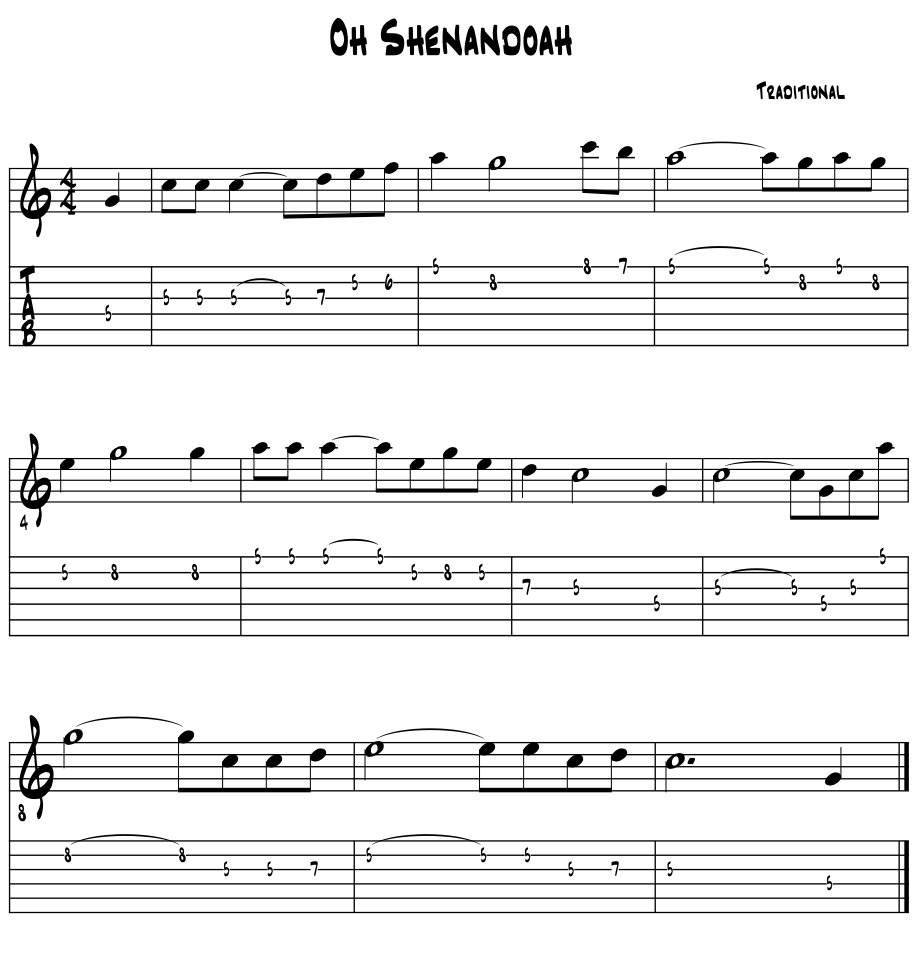 |
"William Tell Overture." Old time European gallop becomes our Americana 'even 1/8th's. And just a hoot of a lick to play somewhere 'in the middle of it all', when we're making it up as we go along, i.e., quoting. Ex. 12. |
|
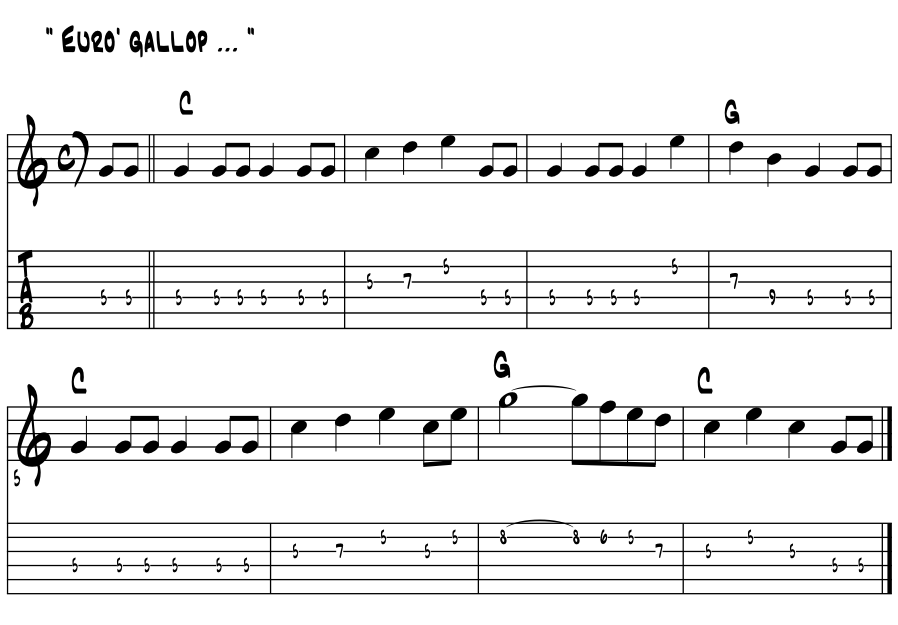 |
Just a hoot of a lick to play yes ? Told ya. There's a whole 'nother part of the song, goes to minor. Clear Americana adaptation of this gallop towards the end of L. Skynard's live "Free Bird." Know a drummer who needs a new encore rhythm riff ... ? |
"I've Been Working On The Railroad." This classic melody might be another one among the first we as kids. Again the 'big 4' sets the march for big swing for the 'A / B' 32 bar form. Once the line is mastered, get Franz on 2 and 4 and find the swing. Motion to Four in the 5th bar is very common. Hipsters of course will run it through the 12 major keys. Interval of the fourth to start out :) Example 13. |
|
"Dock Of The Bay." This first click in is a bit of a curious way into this e-book, as this song is surely under license and thus not included in any mechanical way in this book. There's no recording of, no chart etc. It's here in spirit, in its story and thankfully for its theory, as this song is an amazing portal that opens us up into new realms of advancing harmony :) Why a 'first click in?' First, it's been around for a while, so hopefully familiar and easy to find. In its theory and components, its a unique composition in a couple of super rare ways. Each of these rarities open pathways of theory explorations. It's two parts rarity. One, all chords are major triads, which while not uncommon itself, but becomes quite uncommon, two; when we realize the roots of the song's seven chords build up the Mixolydian mode. That's cool. That's rare. One of a kind even. So with one click we're back to an ancient modal color presented in a modern setting, telling a story of Americana life. |
|
For the composers, Otis Redding and Steve Cropper, the song went to the top of the charts, then kept going off into the sunset of history. So we know it tells a good story in a way all folks can understand and enjoy. Each new generation finding important meaning in its telling. So it's pop styled, has natural sound effects to place song's story into a physical location. In this case by the bay :) And whistling for the solo to take it out. One of a kind? Could be. So all combined a rare song indeed. Find a recording and learn it yourself by ear. First chord is 'G' on an original Volt recording. Know Mixolydian ? Then you know the rest of the root notes of the song's chords. All of which are major. Good one to learn by ear. |
|
"Always think different from the next person ... don't ever do a song as you heard somebody else do it." |
wiki ~ Otis Redding
|
"House Of The Rising Sun." This next melody, is as written here pure, five pitch pentatonic minor and goes way back in our musical history. Based on the minor triad, if there was ever a beginning level melody in minor to bring the juice, this could be tops. As a folk / rock ballad, this song went to #1 back in the mid 60's and is a fave of many even today. Learn it here if need be. Again, through the 12 keys minor for the hipsters. Oh, if a song once went to #1 on the charts as this one did, might it do so again? Example 14. |
|
"Kumbaya" / 'evo a riff.' Major triad motive. Well ya probably knew this melody would be here yes? Got to have one campfire tune that everyone knows in the mix right? Really just a great line that really shows the strength of the major triad to kick things off. There's the classic Four to Three melodic suspension and no leading tone. Probably could work in a shred metal format also. Hipsters of course will probably run this line through the 12 keys. Example 15. |
|
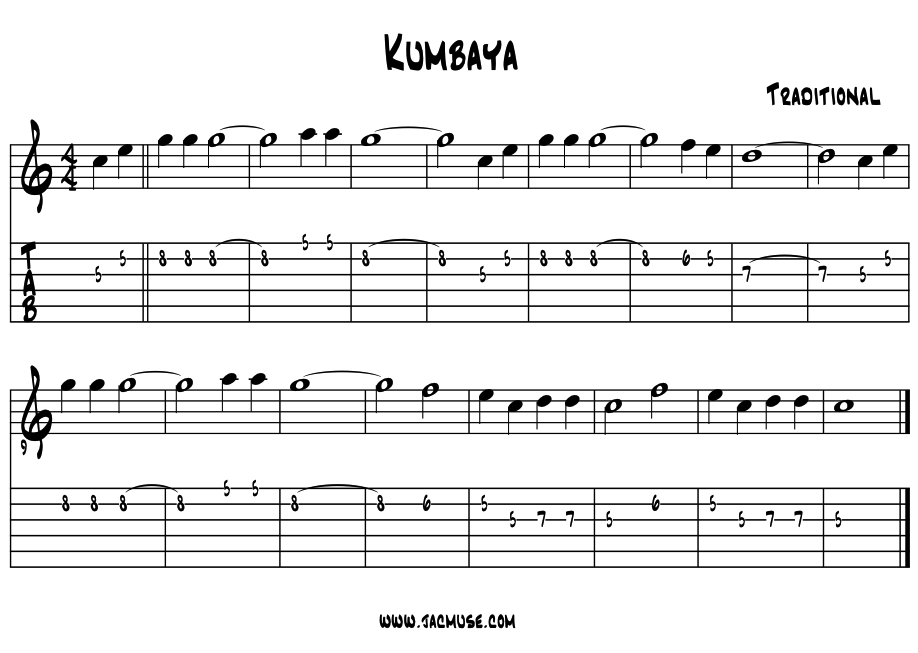 |
Through 12 keys by ear. Just a suggestion, tis an amazing thing that the 'arms around the theory perspective' of our music, one's chosen instrument and facility with pitch, when this sort of melody is mastered by rote and with some feeling, through all the 12 major keys. Even if attempted just one time badly in one practice session will turn on some new lights of insights into your music, try it. Here's the cycle of fifth's diagram to organize the keys. Example 15a. |
|
"On Top Of Old Smoky." This melody has got to be among the top of cliche Americana melodies parodied by kids over and over through the generations, I know me and my pals did. Theory cool in that the tonic triad 'picks up' right up into the Four chord, and it all rolls back on home from there. Thinking in 'C', a classic melody in '3', almost a 'tempo di valse.' Six pitches? Do learn it here if needed, makes for a nice 'waltz' feel when the band needs something in '3' real quick :) Ex. 16. |
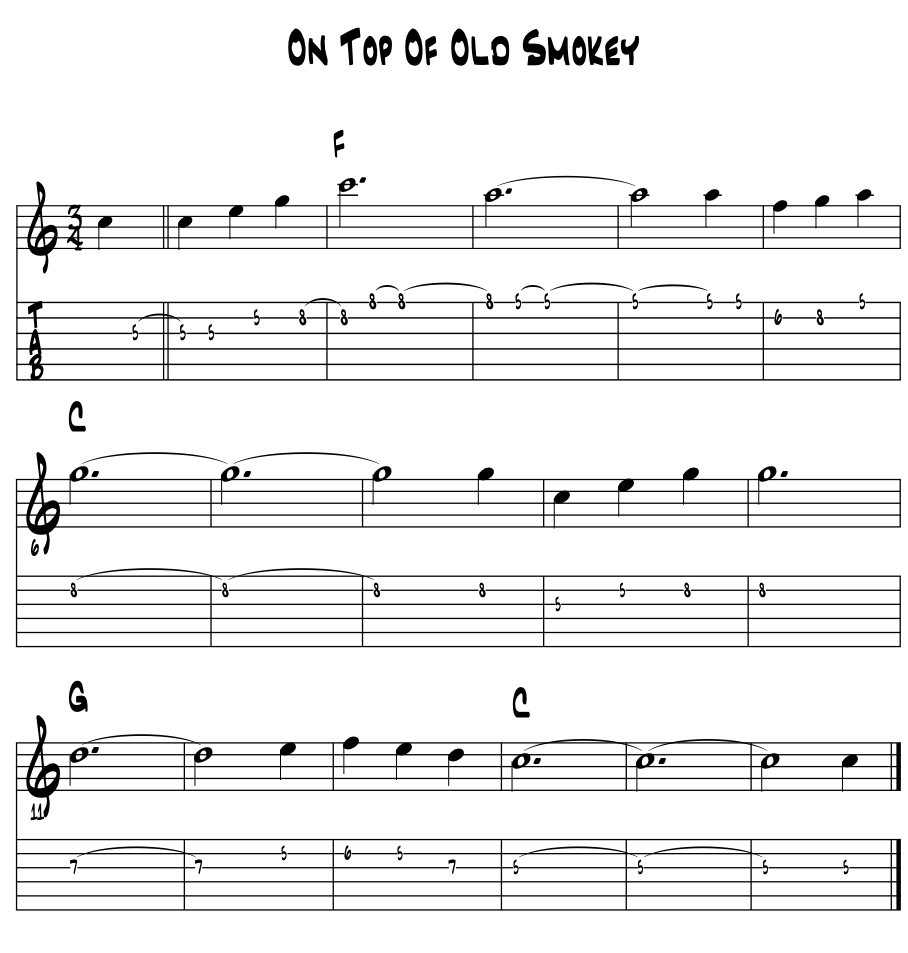 |
"Swing Low Sweet Chariot." This next melody is really just pure Americana gospel. Mostly major pentatonic with an added Four pitch, the absence of the leading tone in the line seems to just bring on the more relaxed spell of Americana gospel. Also a big 4 ~ quarter note swing feel is kinda built right into the line. More built right in Americana DNA magic? Pretty much. Just keep going over it till the swing starts to pull ya. Once you know this physical feeling, you'll remember it for all times. Here's this essential line written out in 'C', learn it here and now if need be. Just an old time Americana gem that brings a true sense of our Americana inspiration. Guitar handy? Example 17. |
|
Glad to have these pitches under your fingers? Getting a smile as your version of this melody comes to life? Cool, there's a ton of juice in this one. 'Swing Low' also creates a solid chord melody arrangement for guitar. An arrangement is included here in Essentials. |
'Three chords and the truth' "Swing Low" is mostly an easy fit with three chords and the truth. In 'C.' Example 18. |
"She'll Be Coming 'Round The Mountain." Man what a tune! Old as the hills and probably straight off the banjo! Quarter note figure of the big 4 insures the wide Americana swing potential with lots of room for phrasing improv. This melody can really invoke the gallop; that trick of rhythm that sets a musical thing into motion. For between swing time and the gallop to kick it off, lies the vast Americana danceland of the big 4, as happening a groove and pocket as ever filled a dance floor. Here's the line to be rote learned. Eventually all 12 major keys for the hipsters in the room. Example 19. |
|
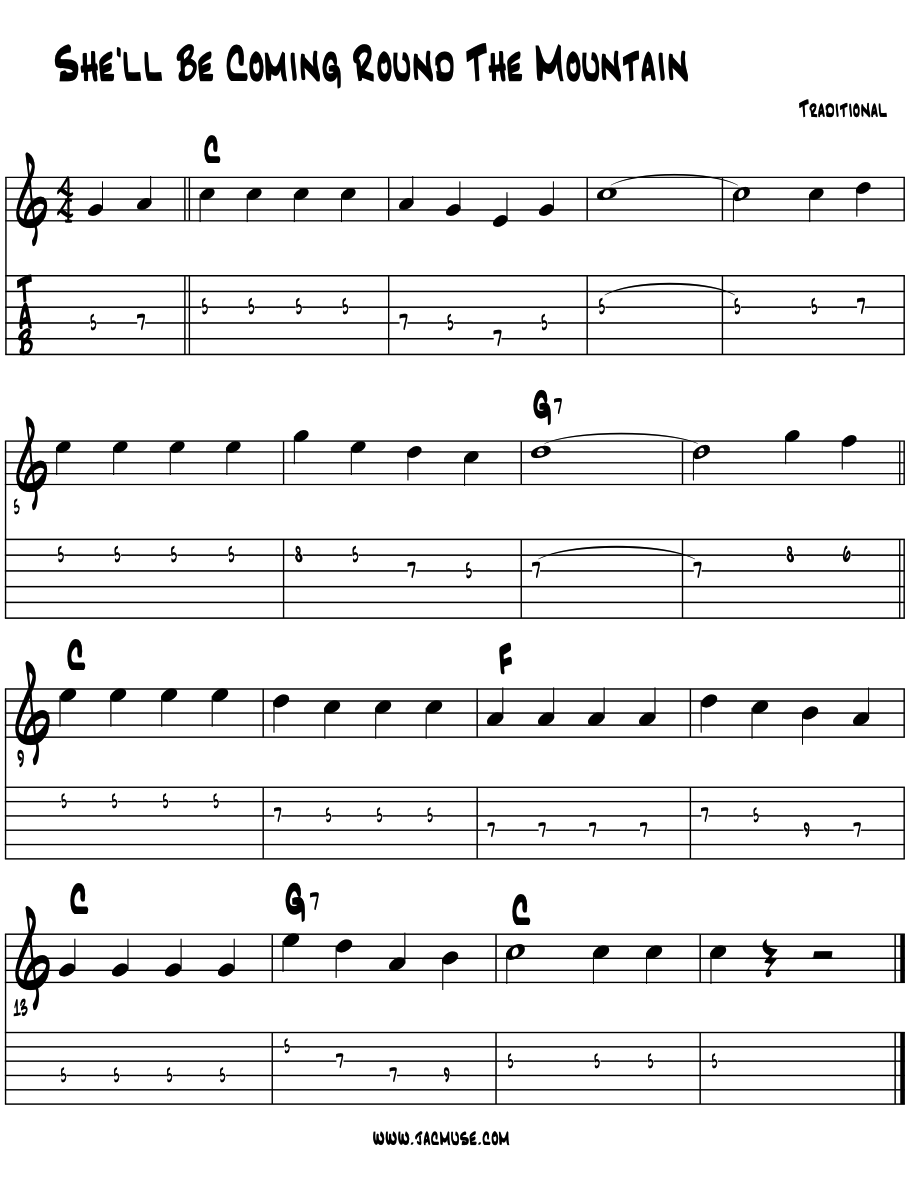 |
"Amazing Grace." Into the waybac machine to go gospel again here to find a gentleness of melody as unsurpassed in tenderness and humility as any written so far. The gallop rhythm nudge from just above here written in as the triplet in the very first measure. Purely pentatonic major in its pitches, a perfect balance of two, eight bar phrases becomes an everlasting a gem to be mastered. Classic example of the role of harmony; while there's no fourth scale degree in our melody we can clearly go to the Four chord in the third measure. Three chords and the truth do often rule the day. Example 20. |
|
 |
"Go Down Moses." The story of the Jewish diaspore from wayback and later just a classic Americana gospel melody sounding to be set free, set in the minor tonality. The opening leap of the minor 6th sets the perfect mood for the longing message of freedom. I learned this song back in elementary school, probably sang it with gusto and created parodies with it a million times since. Big quarter note swing in the minor 'a la Wes' in octaves is built right in and in this arrangement we borrow the leading tone 7th from the harmonic minor to boot to fill out a full V7 chord. Here in E minor, these are some powerful pitches. Find them and learn by rote and they are yours forever. Example 21. |
|
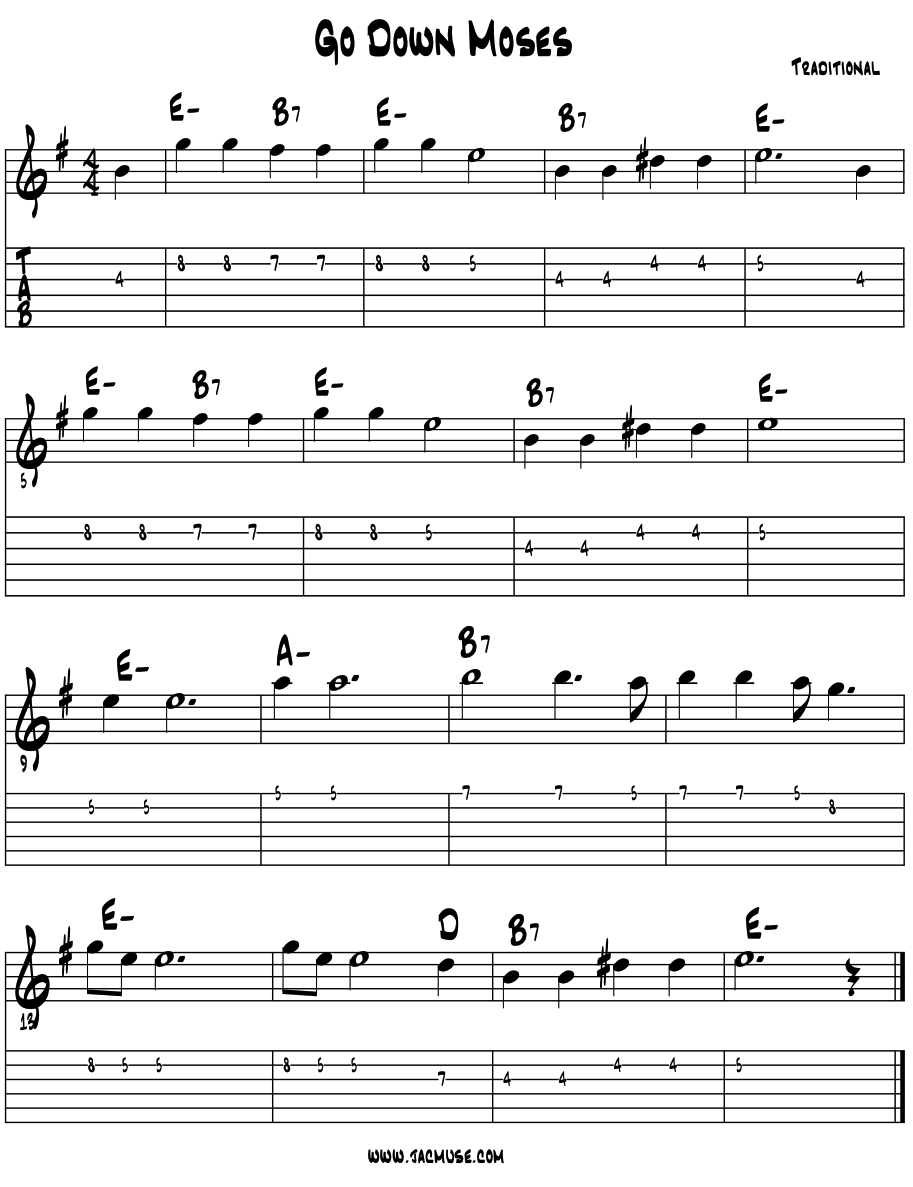 |
"St. Thomas." This next melody is mostly known today as a Latin jazz melody. Originally a folk song from the Caribbean, made popular by tenor saxophonist Sonny Rollins in the mid 50's, St. Thomas is a lovely example of a perfectly balanced set of four, four bar phrases that structures so many of our coolest and most historically popular Americana melodies. The last phrase, even without accompanying harmonies, is quite remarkable in its simplicity and perfect cadential closure of pitches. A joyous melody that just has the dance built right in, St. Thomas brings the natural merge of quarter note swing and the Latin sense of things. Written here in four, it is easily felt in the '2 feel' of the samba. Ex. 22. |
|
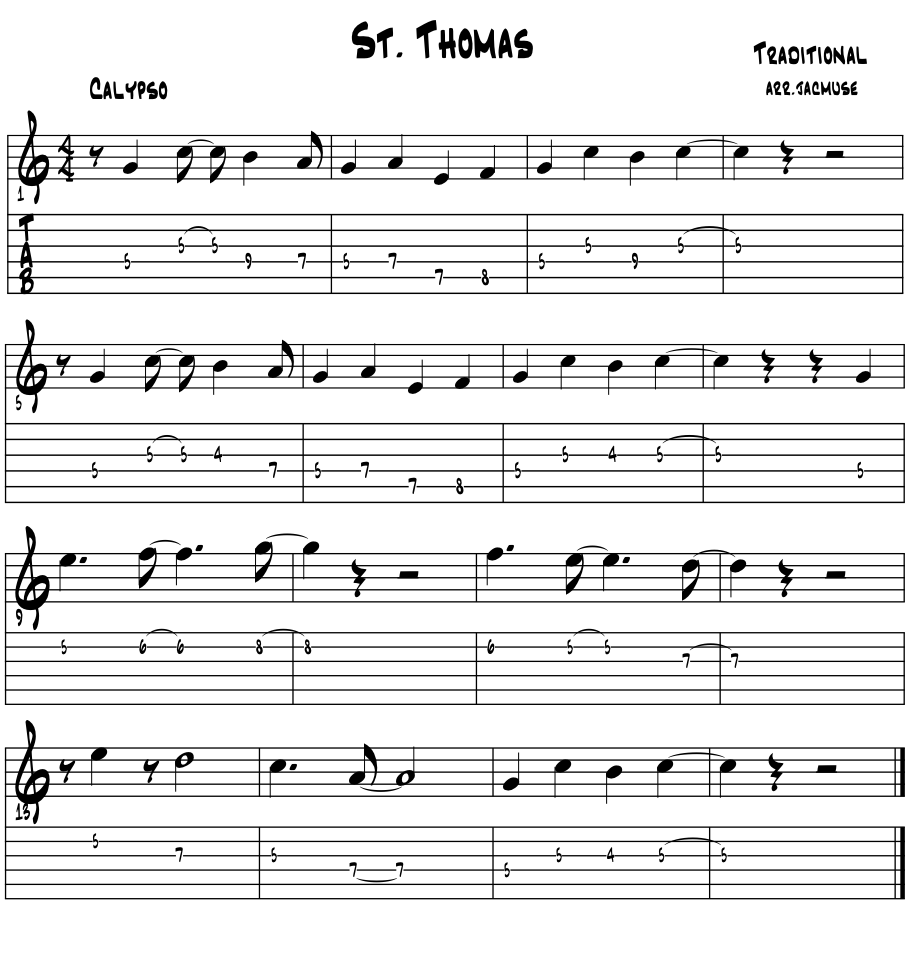 |
A first click in and its off to "Scarborough Fair." "Scarborough Fair" holds a special position within this text. For it quickly initiates a few ways into this book's content; a lovely melody to rote learn, in a minor key that ventures to major and back, two eight bar phrases and a unique, modal bass line story, for starters. Plus a near top 10 hit for the the last four centuries or so. Learn of it here today if need bee. |
|
 |
In pitches and tunings, we can trace it back to an era when our pitches were organized in the olden days of the Euro modal system. Thus, it is among the oldest melodies within this book, if not the oldest, and written with Dorian pitches. Meaning ? That it has had a couple of centuries worth of potential influence on what has come after. So in essence, coming to the America's on the Mayflower, we've had this melody here all along. Rote learn its magical pitches here and now if need be. |
|
The melody and form of "Scarborough Fair" provides two eight bar phrases that follow the classic, essential home / away / back home motion. In our theory this most often becomes starting on the tonic / One / chord, going away to dominant / Five / chord, then finding a way back to One and home. |
This sort of melodic motion is the basis, really the first valence of melodic meanderings throughout the pitches. One to Five to One. We see it near everywhere in songs to tell our stories. Advancing classical players reading here can read this as 'modulating to the dominant.' A super common feature in the sonata allegro form of the Euro masters and beyond. |
Bass line story. "Scarborough Fair" is an interesting bass line story. Probably written before before the homophonic style was fully in place, the chords / bassline seem a bit unusual to today's root motions. Yet even just pushing the buttons of the roots of the chords brings the song's character to the fore. |
As a thread into our discussions, we gain many ways in to our studies and discoveries by rote learning this song. Once committed to memory, we've now a song to share in common together, creating a basis of communicating and dialogue. Emulating it's poetry, we can move right into the composing and writing of our own lyrics. Or delve right into the early modal organization of our pitches and from there, either go waybac back to Pythagoras, or forward a couple of centuries to equal temper tuning. Also, there's just the basic discovery of the song itself, mastering the pitches by heart, beginning the process of theme and variations which bases our own creative improvisations. |
This melody is a classic folk melody in the minor key. With a true hint of the Dorian mode in measure 7, just a lovely and balanced line. Four, four bar phrases, with a repeat of the first idea or motive to close the melody, form the 16 bars of the song. |
Quite a BIG hit for Simon and Garfunkel in the 60's, "Scarborough Fair" has long long been a favorite of many. Make it one of yours perhaps or even just get it under your fingers a time or two, to quote somewhere along your melody way. While the melody tells the tale, the harmony is tricky (?) thus negotiable, simply find other versions to help create your own arrangement. If needed, learn it now. RO ! Thinking 'A' minor. Ex. 23. |
|
 |
Cool huh ? Octaves rule ! :) The harmony / chord changes written in the chart are from the 17th century, probably. Might be best to work out a chord melody arrangement. Then modify the changes over the 16 bars to more of a 'three chords and the truth in minor.' Chord root notes in 'A' minor for two, eight bar phrases (2nd phrase in bold type). Example 23a. bars: 4 / 2 / 2 / 2 / 2 / 2 / 2 roots: A- A- E- A- D- A- E- |
Thinking style. "Scarborough Fair" has been covered by many many recording stars, went top 40 a couple of times probably. even to top 10 at one point. probably a #1 hit in its day. Great folk song with open chords. Pop rock with solid chord tone lines and a solid progression for creating vocal harmonies. Jazz players should find the Wes Montgomery recording to help ya bring the wide swing that Montgomery brought to everything. |
"Billy Boy." This next melody might be known today mostly as a nursery rhyme. Energized by the 'big 4' beat, we gain the big swing potential. In one sense, the two eight bar phrases in its form becomes a sort of half or 'mini 32 bar A B' song form, which structures a gillion or so songs. "Billy Boy" is included as a piano trio arrangement by pianist Red Garland on a recording often considered to be among America's greatest jazz albums. Titled 'Milestones' by the Miles Davis Sextet recorded in 1958, Mr. Garland's own 'two fisted' chordal block styling recreates this children's melody with a seemingly bottomless sense of swing. Learn it hear if need be. Just sing the melody and find the pitches on your ax. Example 24. |
|
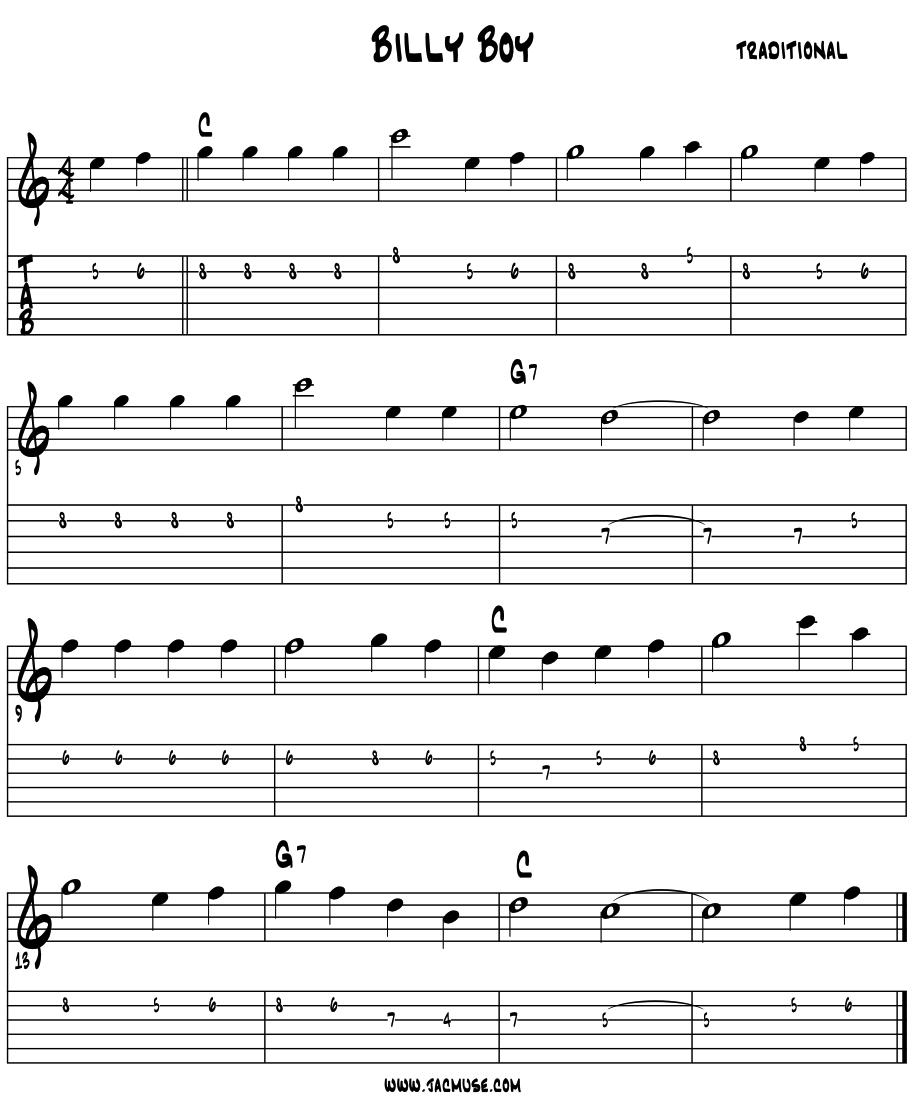 |
"Greensleeves / a ballad." This next melody goes all the way to back and across the pond to the Elizabethan era in merry old England, when Shakespeare's Globe theatre was the best gig in town and iambic pentameter was still the rage. "Greensleeves" is a song with two contrasting themes that balances between the core Yin / Yang ~ major / minor colors. We start out in minor, modulate to major and return to minor to close the song. Surprisingly (?) that there's no Picardy 3rd written to close the line. Pairing relatives 'E' minor and 'G' major with a few extra pitches thrown in for good measure :) Example 25. |
|
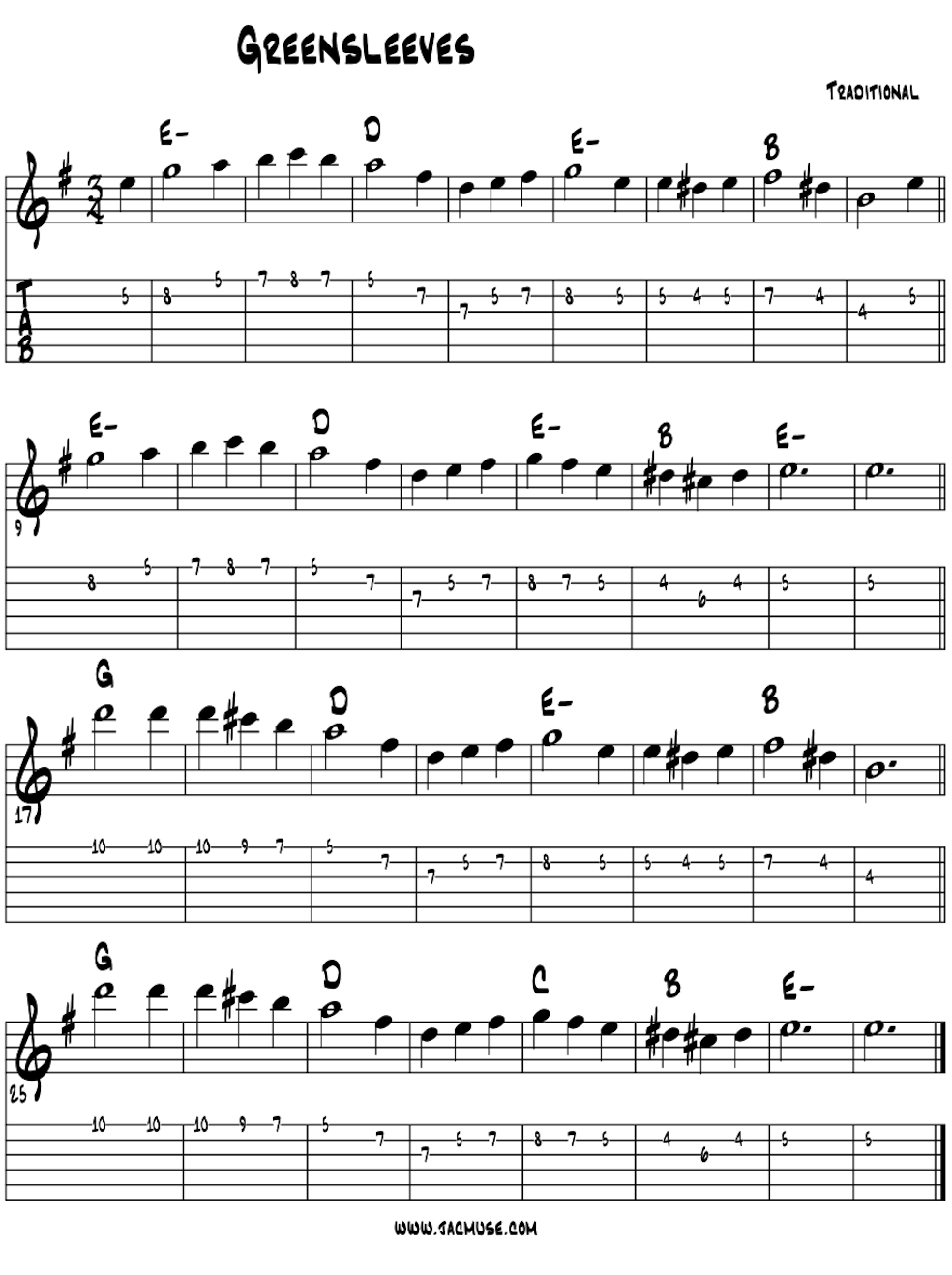 |
"The Bear Went Over The Mountain." This next melody goes all the way to back into an early childhood memory. Learn it hear if need be :) A pure 'six pitch melody', somehow it ended up in bass clef. Ex. 26. |
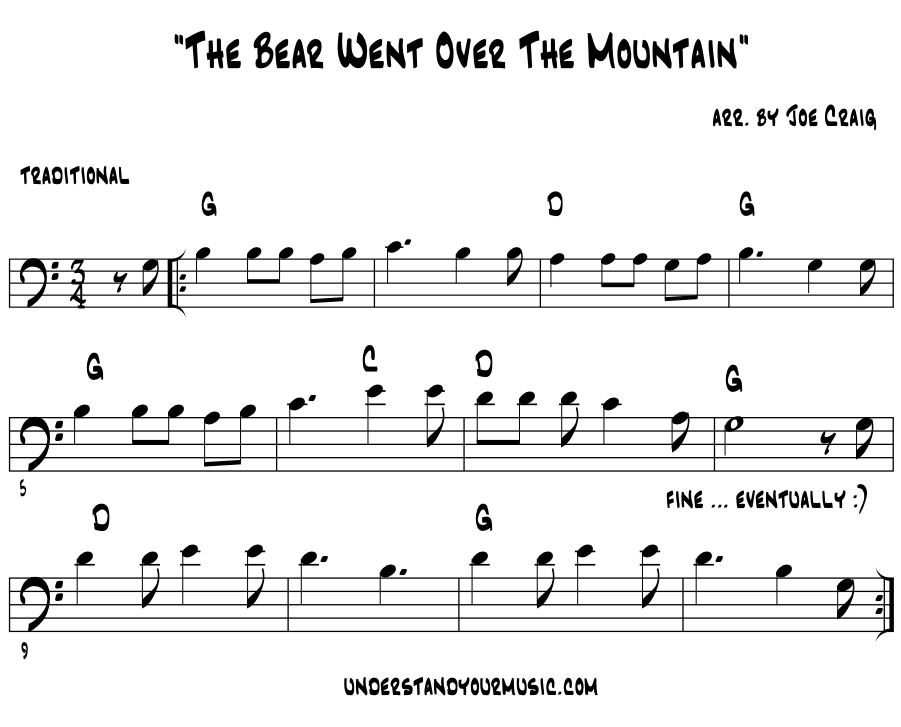 |
"La Cucaracha." We head for the vastlands of the Americano Southwest to find this next melody. How is it that a couple of pitches in a rhythm can so quickly evoke a cultural source and inspiration? Surely there's a magic beyond just cliche eh? |
Here in 'C' major, two four bar phrases, the melody note motifs of both phrases start with the pitches of the diatonic One and Five triads followed by stepwise, scale motion. The first phrase is centered on the tonic One moving to Five ... what no motion to Four ? :) The second starts on Five and heads back to One. Just a perfectly balanced, antecedent / consequent, call and response styled melody that everyone in the room could very well know, thus enjoy. Example 27. |
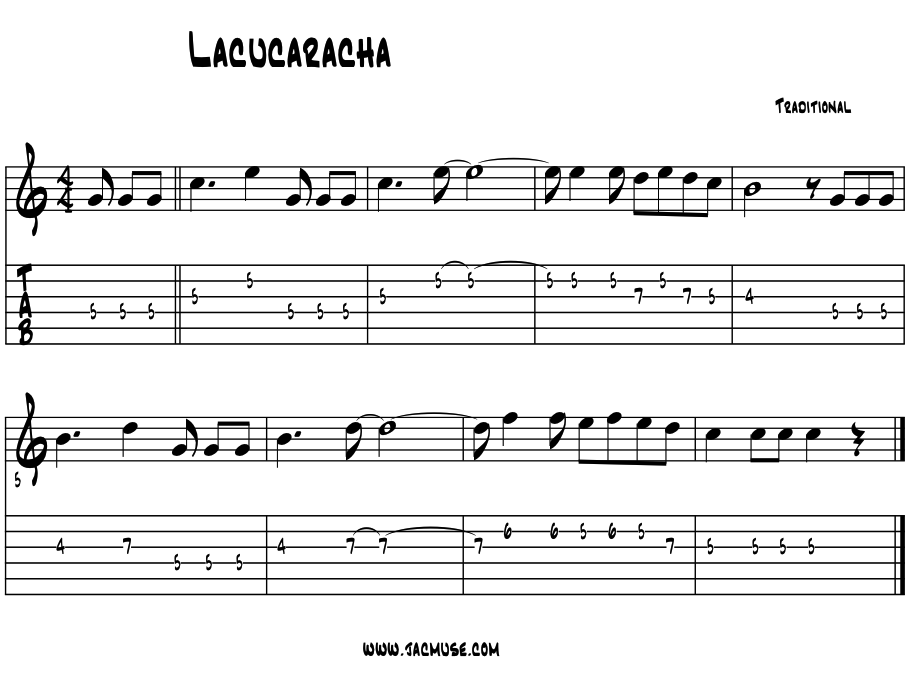 |
"Superhoot theme." Since we're working the triads, this next melody came one morning after morning prayers for dear folks now departed. Shared in the spirit for all Moms and Pops who love music too, and dance along and sing with their kids each day through :) |
Here in 'A' major, two eight bar phrases, the melody note motifs of both phrases start with the pitches of the diatonic One, Four and Five triads followed by a hint of chromatic motion. Makes a fun dance tune for kids, a break tune or incidental music, for the band. Run it through all 12 keys as a warmup. Example 28. |
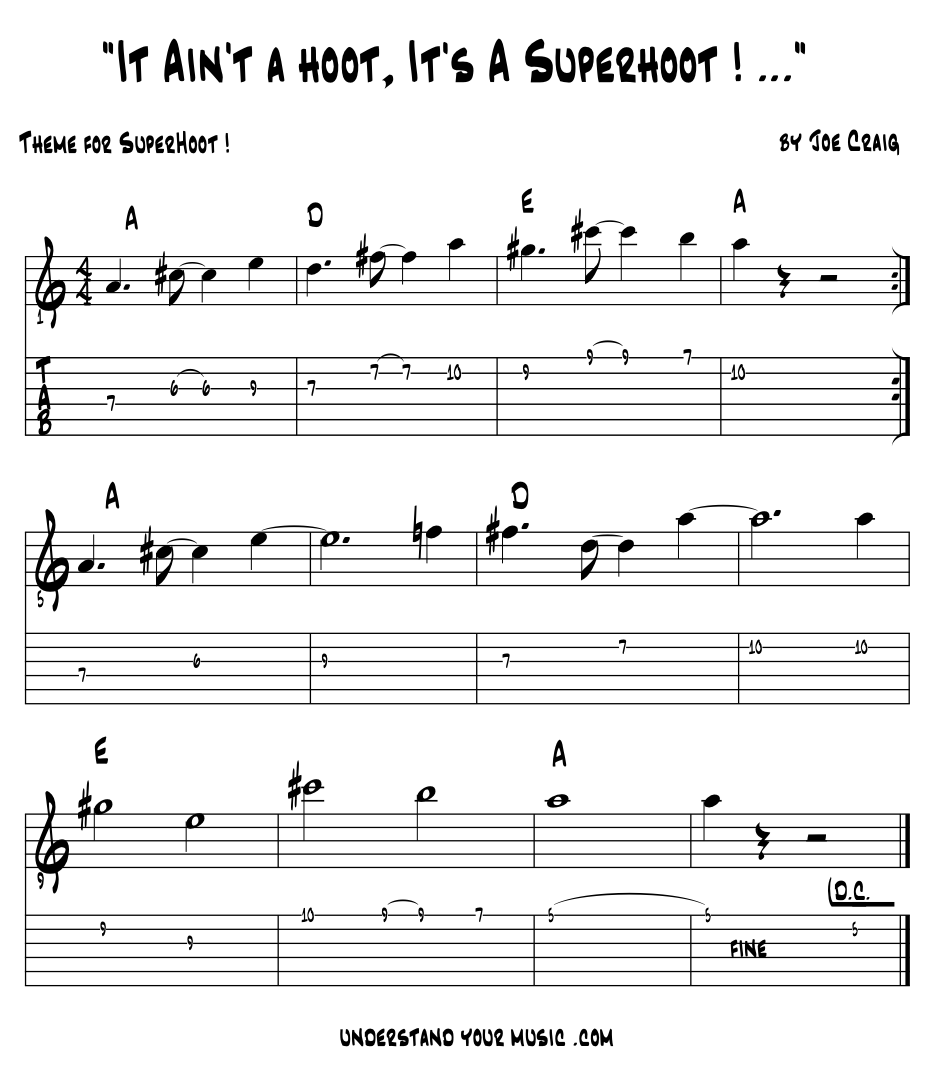 |
"Oh Susanna." This next melody is really classic Americana. Again we feel the jaunty American musical flavor of early Americana created by the major pentatonic group of pitches. In this melody we find a sixth pitch, the essential Four, which opens the second half of the tune. Written by the 19 century Americana composer Stephen Foster, his song has been recorded by dozens of top stars over more recent decades. The arrangement by folk / pop artist James Taylor is a wonderful example of diatonic harmonies and passing chords covering a classic Americana melody. |
|
"Oh! Susanna" also makes for a great bluegrass melody and vocal song in a brighter tempos, another melody that surely one everyone in the audience should know. A mandolin styled, offbeat rhythm comping of 'one chuck two chuck' works the magic behind these sorts of old timely melody lines. Written here in an A A B form with the repeat sign, two verses then the chorus. Ex. 29. |
|
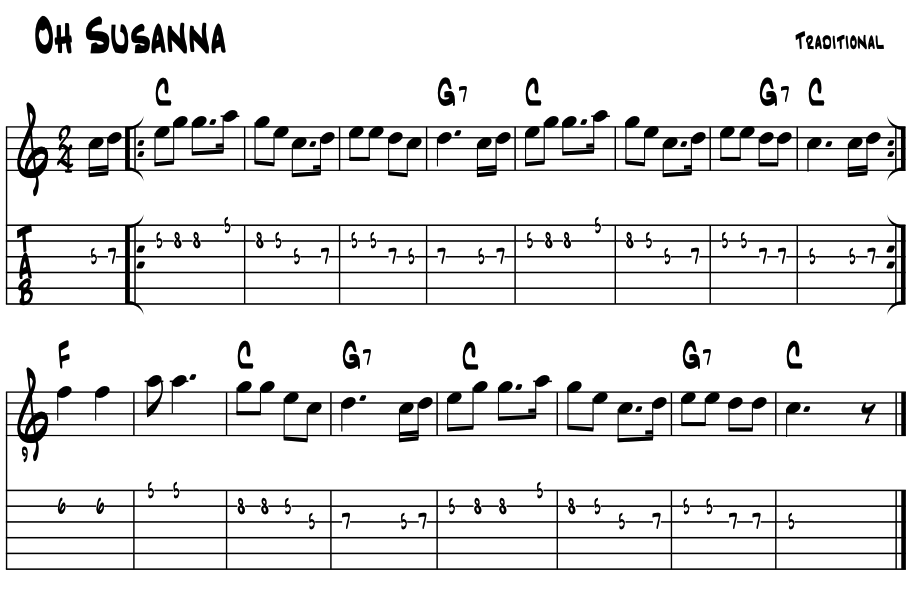 |
"The Sidewalks Of New York." Just a great old melody in 3 with an interesting melodic form of 32 bars. Perhaps the one true 'waltz' tune included here, think '123 123 etc., to get this one going. Nice 4-3 suspension in bar 12 and an easy going descending sequence in 3rds in bar 17. Example 30. |
|
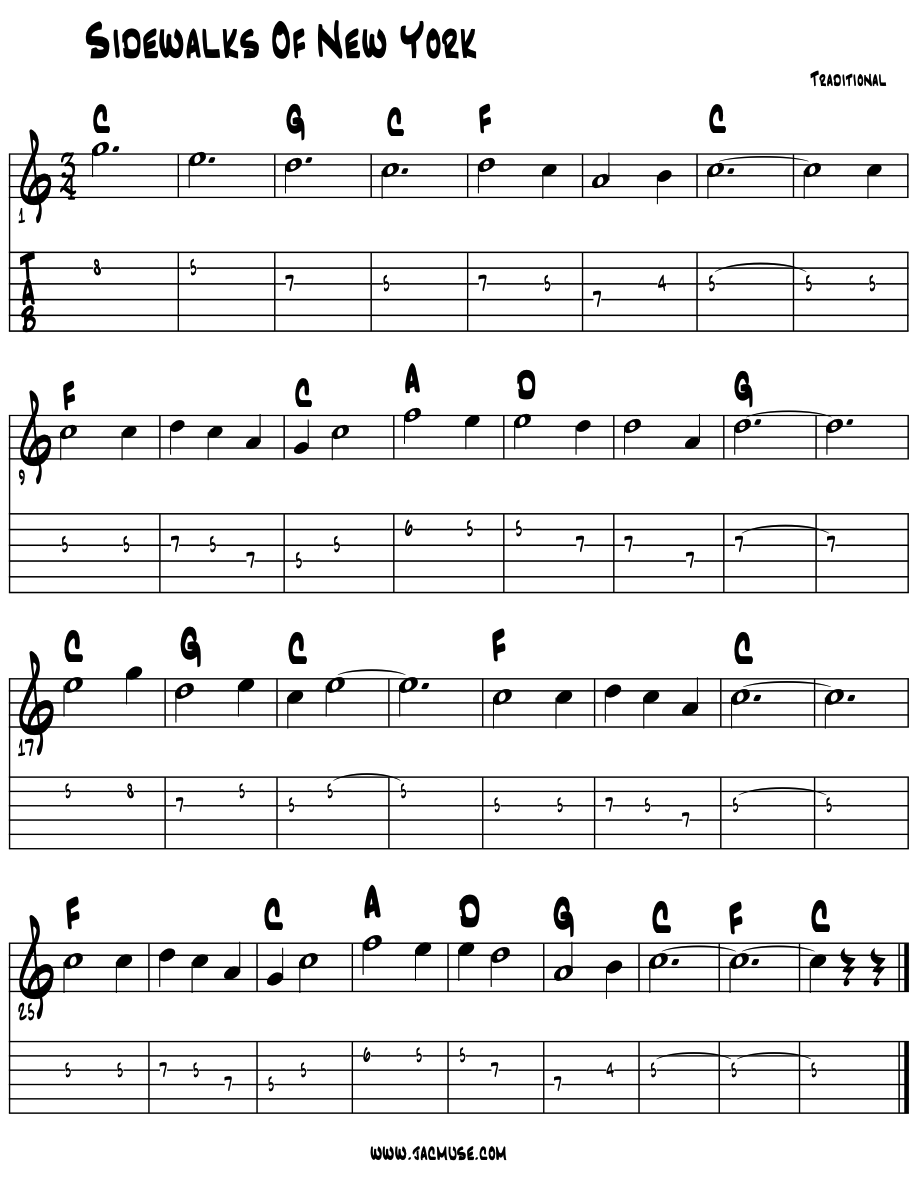 |
"Take Me Out To The Ball Game." This melody is really classic Americana as it is part of the tradition of the sporting game developed in America originating here in 1850's. Written in lolly gagging sort of 3/4 waltz time, suggestive of a relaxed afternoon spent out of doors among friends and community, the melody line opens with an octave interval leap, our interval king if you will, that bases our whole system of music theory both art and science. |
|
This melody is probably among the best known lines in all of America today, for millions of baseball fans get to sing it during the '7th inning stretch' in many ballparks. Usually played by the organist, learn it here by rote by first singing the melody and then just finding the pitches on your instrument; fist pitch 'C', then up an octave etc. |
While mostly diatonic in its pitches, there's a beginning hint of melodic chromaticism in bars 9 and 28, that while surely adding interest to the line, are also the same sorts of pitches that opens up new improv opportunities for soloing through the non-diatonic chords they can help generate for the evolving guitarist. Example 31. |
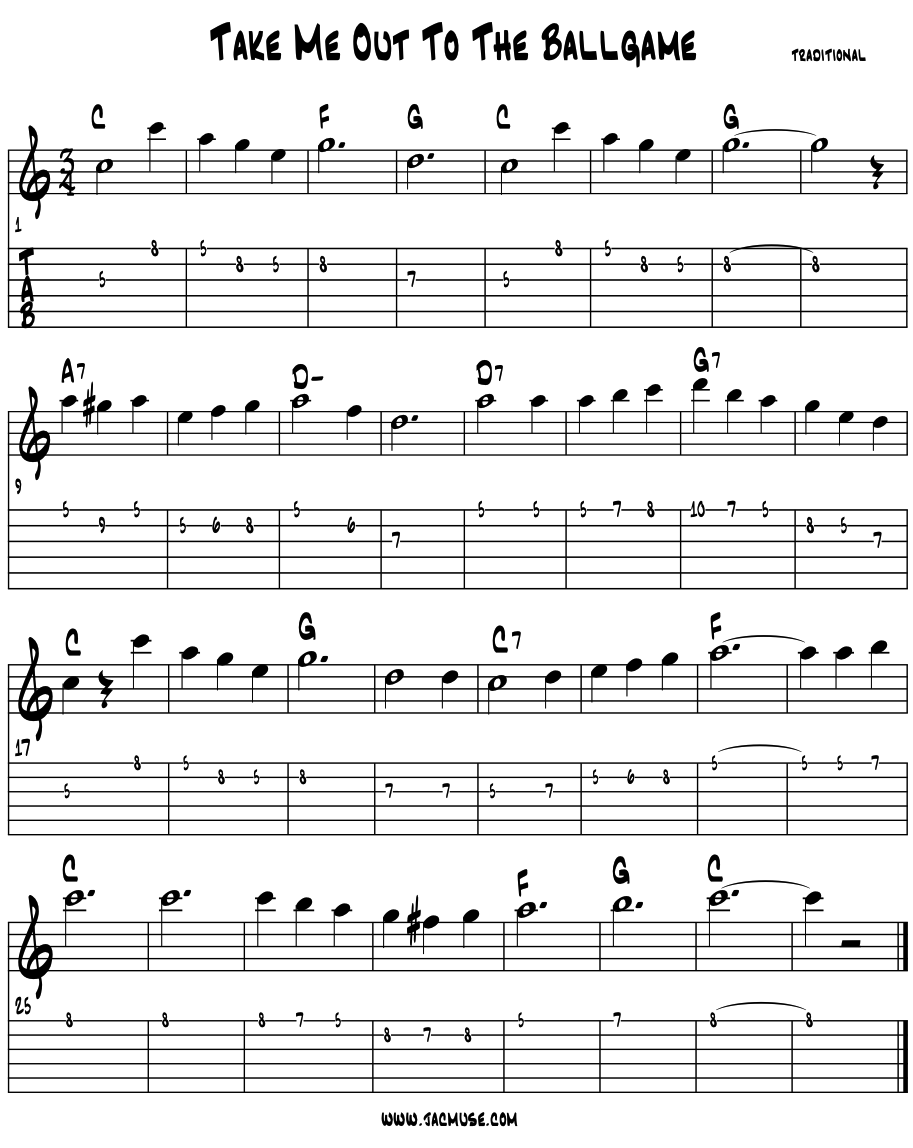 |
"When Irish Eyes Are Smiling." Back in 3, this lovely major triad based melody has a built in smile as its title implies. Written in a perfect A B 32 bar form, where the opening idea is most often restated verbatim in the second 16 bars then altered a wee bit to create a solid melodic and cadential motion to bring the line to a solid conclusion by bar 32. This melodic treatment is very common in this form. Recorded by many top stars along the way, an easy quote to bring the 'smile' to other songs too. Example 32. |
|
 |
"Michael Rowed The Boat Ashore." This next melody is also really classic Americana folk and went to #1 on the radio play charts in 1961. Spiritual in nature, again our melody starts off with the pitches of the major triad. (There seems to be a lot of triad melodies on this page.)Again we see the pentatonic five enlarged by one additional pitch to include Four, while Seven is not present, so no leading tone for the melody but surely of we had chords in this arrangement. So really just a super nice example of the balance of two, four bar phrases. The first phrase gets us to Four and back to One. The second phrase is basically One / Five and back to close on One. Thinking in 'C' major. So an eight bar folk song went to #1 ... nice. Example 33. |
|
 |
"Old Joe Clark." This next melody is as 'old as the hills' I'd imagine. A transplant from the old British Euro country to our new Americana country probably during the early 19th century. "Old Joe Clark" is more old 'timey' or bluegrass today than true folk depending on the players I guess. What is super clear in its pitches, intervals and their sounding is the Mixolydian grouping of the pitches that creates this classic Americana sound. Here we see in the following arrangement its 1/8 note magic, that becomes the 'lingua franca' of true swingsters for the last 100 years or so. Note the same initial melodic 'call' idea in the first four bar phrase as in the second, which ends a bit different creating a sense of closure to the line. The followed by the 'response' in bar 9. Example 34. |
|
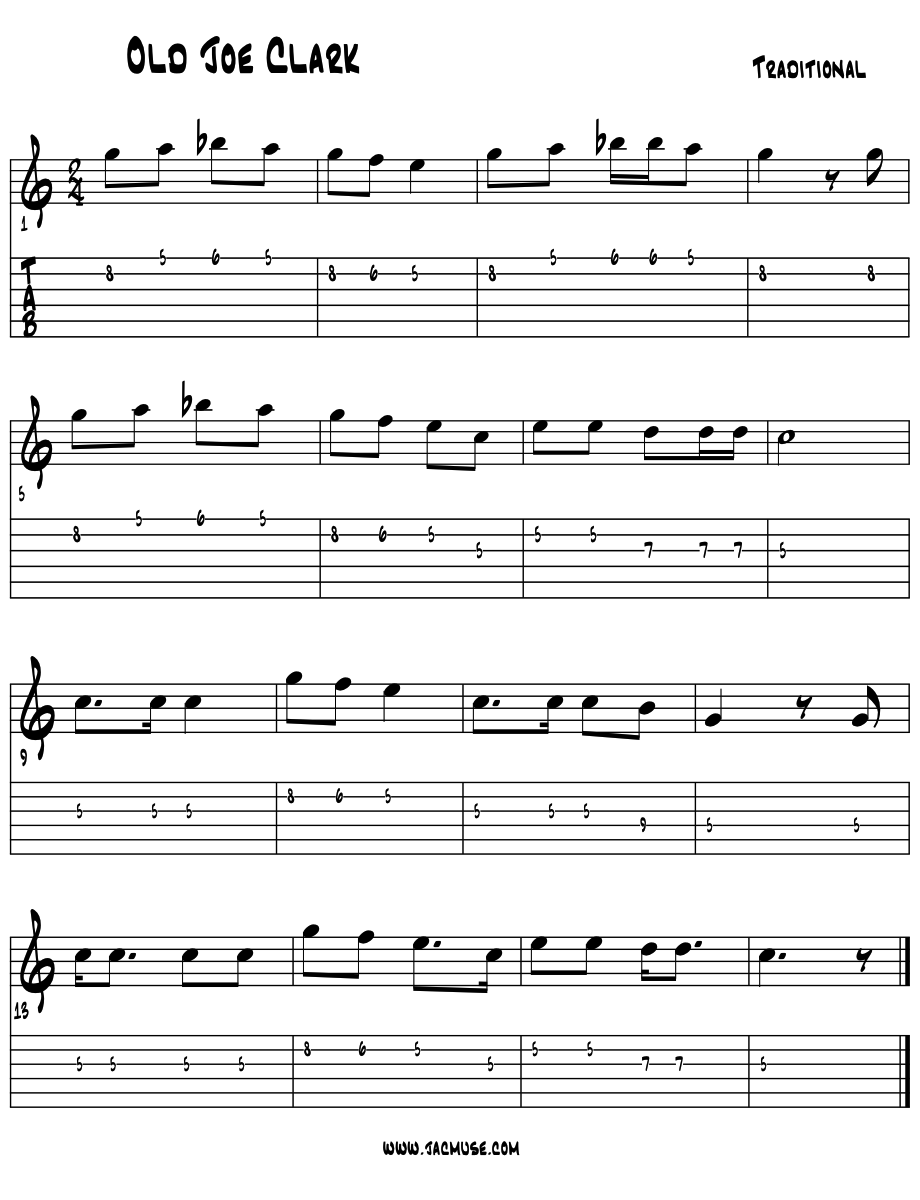 |
"Yankee Doodle Dandy." Surely into the waybac to find this melody, back to when the American dream was still just a dream and the folks on the scene were working very hard to bring it all about. Again the super quarter note big 4 march brings the swing right near to our fingertips yet again. A totally diatonic Ionian major scale group of pitches which creates this whole melodic idea. Learn it all right here if needed and all 12 keys for those hipsters in the room. Example 35. |
|
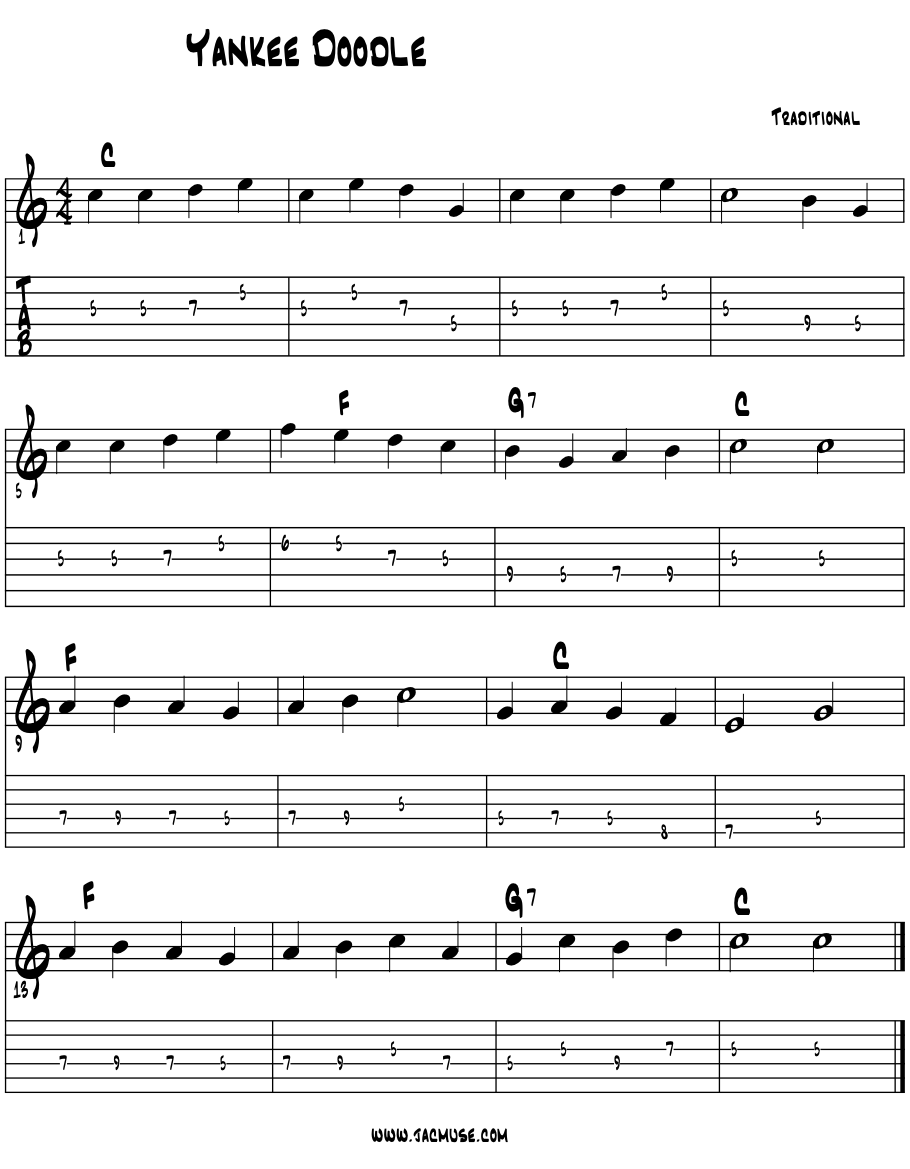 |
"Yellow Rose Of Texas." This country leaning song and melody turns out to be as perfect in combining four bar phrases as any we might have. Again using the full compliment of the seven pitches of the major scale, combined with the quarter note feel captures the early style and sounds of the Americana West era. |
|
The pickup to the line; the 5 - 4 - 3 pitch motion, motored by the big 4 sets it all off, the pitches are major triad and Six. The diatonic interval leap of a sixth in bar 13 is a common, solid way of energizing a cadential motion a melody back to close upon its tonic pitch. Easy to imagine a bit of added drum cadence after the last pitch. Learn this melody here if need be. Pro leaning country artists should review the lyrics also. Ex. 36. |
 |
"Jolly Old St. Nicholas." A holiday favorite from way way back, stepwise diatonic motion from Three to One wins the day for the opening phrase. We use only six pitches of the major scale, the perfect fourth / Four is not present, yet the harmony can easily go to Four in each of the phrases. goes to Four a couple of times. A sort of 'mini A / B' form, two similar eight bar phrases. The first closing on the second scale degree, the latter closing to the tonic. An easy way to expand one phrase into two :) Example 37. |
|
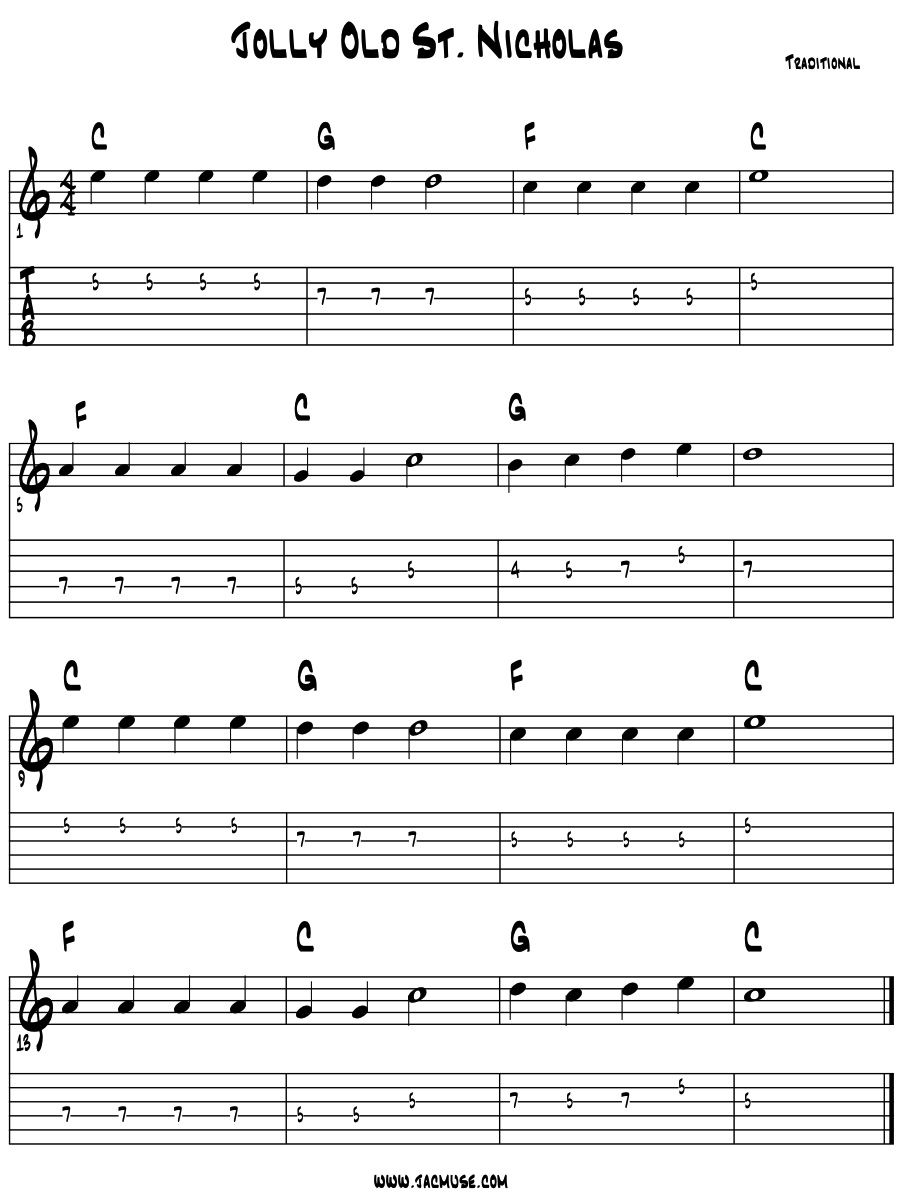 |
"The John B Sails (The Sloop John B)." This next melody is a folk song originating in the Bahamas of the 19th century to be discovered and recorded in the 20th. And with some Hollywood polishing, it gets to #3 on the top 40 chart for a couple of months or so for the Beach Boys, a West Coast group that featured some hair raising vocal harmonies from back in the 60's. Not too shabby a payday for a century or so old song :) |
|
Just a neat and purely diatonic major scale gem of a melody line, the opening major 6th leap from Five up to Three starts us off with a lovely '4-3 sus' in the line, our rhythms set up an off beat pulse that consistently creates the forward motion for the melody phrasing. This offbeat feel is a mainstay of what Latin rhythms bring to the American musical pie, the core of these offbeat rhythms helping to create a new focus on the second and fourth beats. So ... 2 and 4? Yep, 2 and 4, the backbeat that powers most Americana. Example 38. |
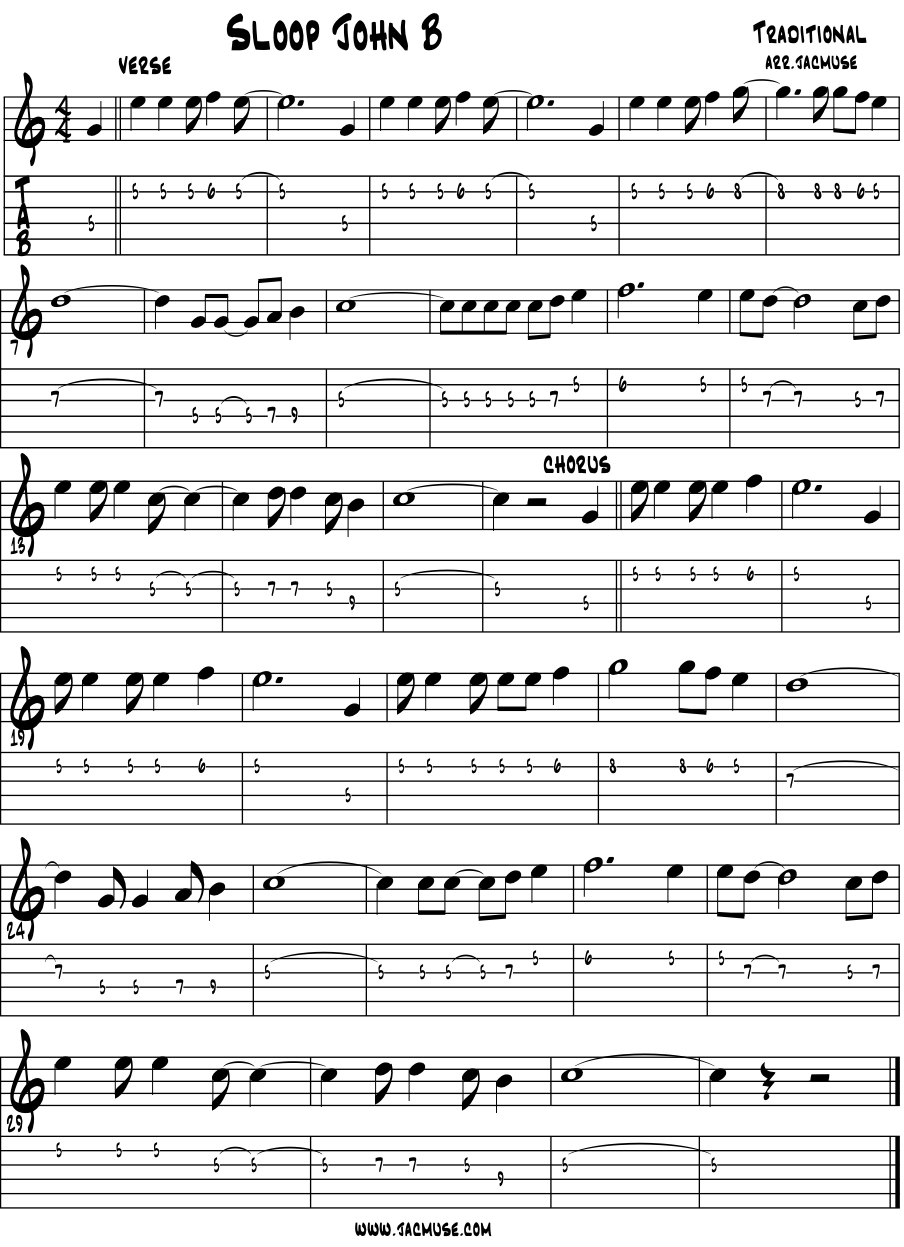 |
"Careless Love." This next melody takes us back to the dawn of the 20th century where it was said to be a favorite song for New Orleans musicians. These origins making it possibly one of our first jazz compositions that got played a lot. With its diatonic major scale basis, two eight bar phrases and a written in chromaticism giving us some of the true blue hue itself. The song closes with a sequential off beat lick, perfect for the essential 'three times and out' 'arrangements while you wait' to close out a performance of the song. This 'three times and out' probably the most common of our improvised, negotiated on the bandstand endings. Example 39. |
|
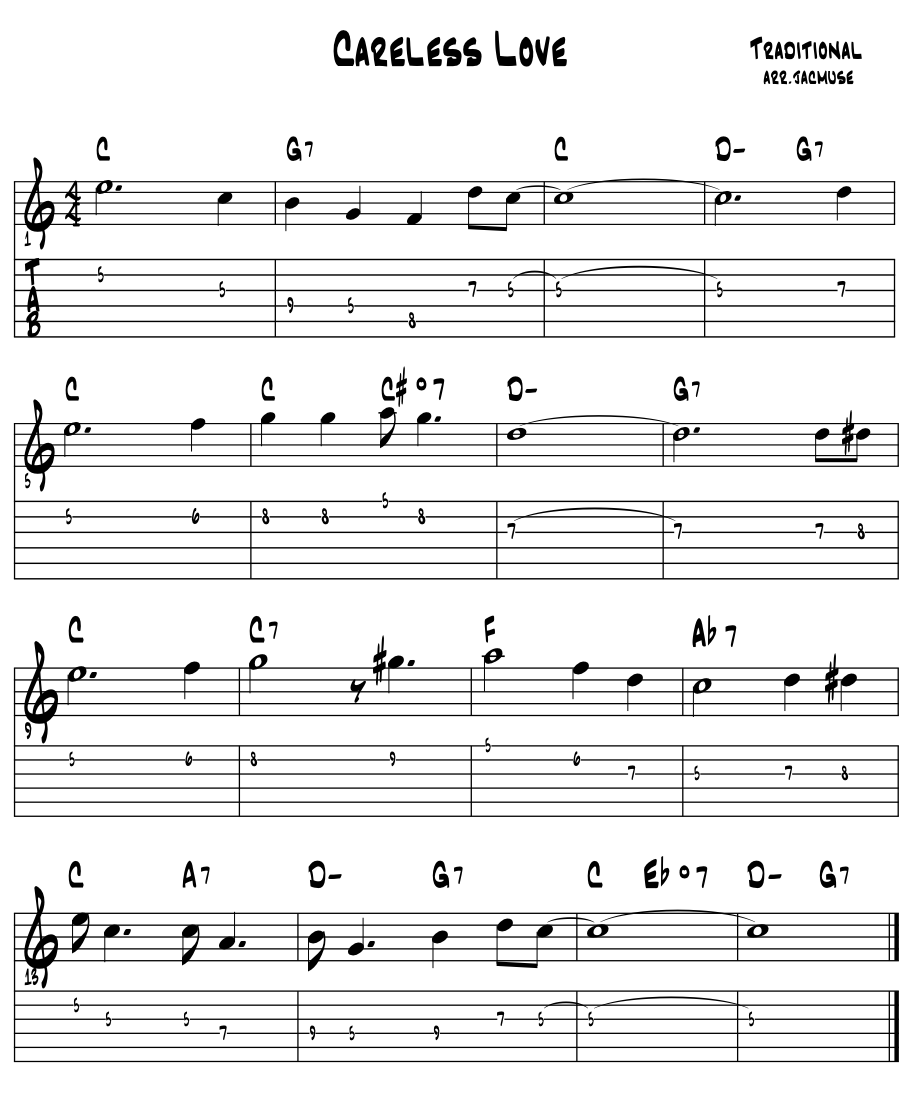 |
"Sweet Georgia Brown." This next melody also takes us back to the dawn of the 20th century, 1925, where it was said to be a favorite song for New Orleans musicians. These origins making it possibly one of our first jazz compositions that got played a lot. It backpedals / cycles the V7 chords by 4ths, a common harmonic scheme that returns again and again with through all songs in all styles through all the decades. In modern day times, when in advanced theory all the chords of a song become V7 styled, with color tones and substitutions to boot ... wow look out ! And grab the colors to create that chromatic blur of the modernistas. Example 40. |
|
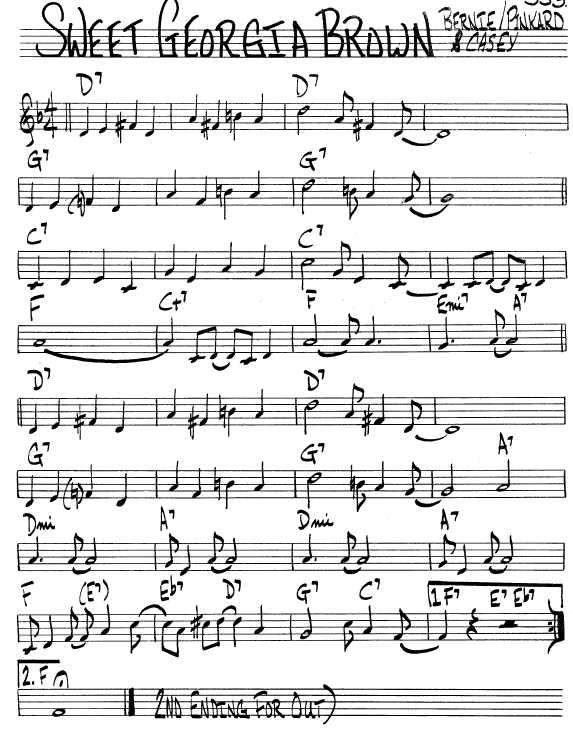 |
"Sweet Georgia Brown." This song just entered into the common domain at the stroke of midnight, 2021, enabling its inclusion in this text, wow ! :) |
|
"Auld Lang Syne." Surely into the wayback to source this five pitch aire. Clearly major with the tonic established on beat one with a Five / One resolution, the line builds to Six by the end of the first four bars. A Five / One cadential motion same as the opener, brings this melody line to a solid resting place. This melody is probably the oldest in this collection. Pro leaning cats might rote learn it here as it is just a super unique group of pitches, it gets played every year at tons of gigs, some of which are HUGE paydays, and even when sung by the hearth, at the appointed minute, sentient warmth and community flourish beyond historical measure, resetting a loving 'tone' for the next year to come. Example 41. |
|
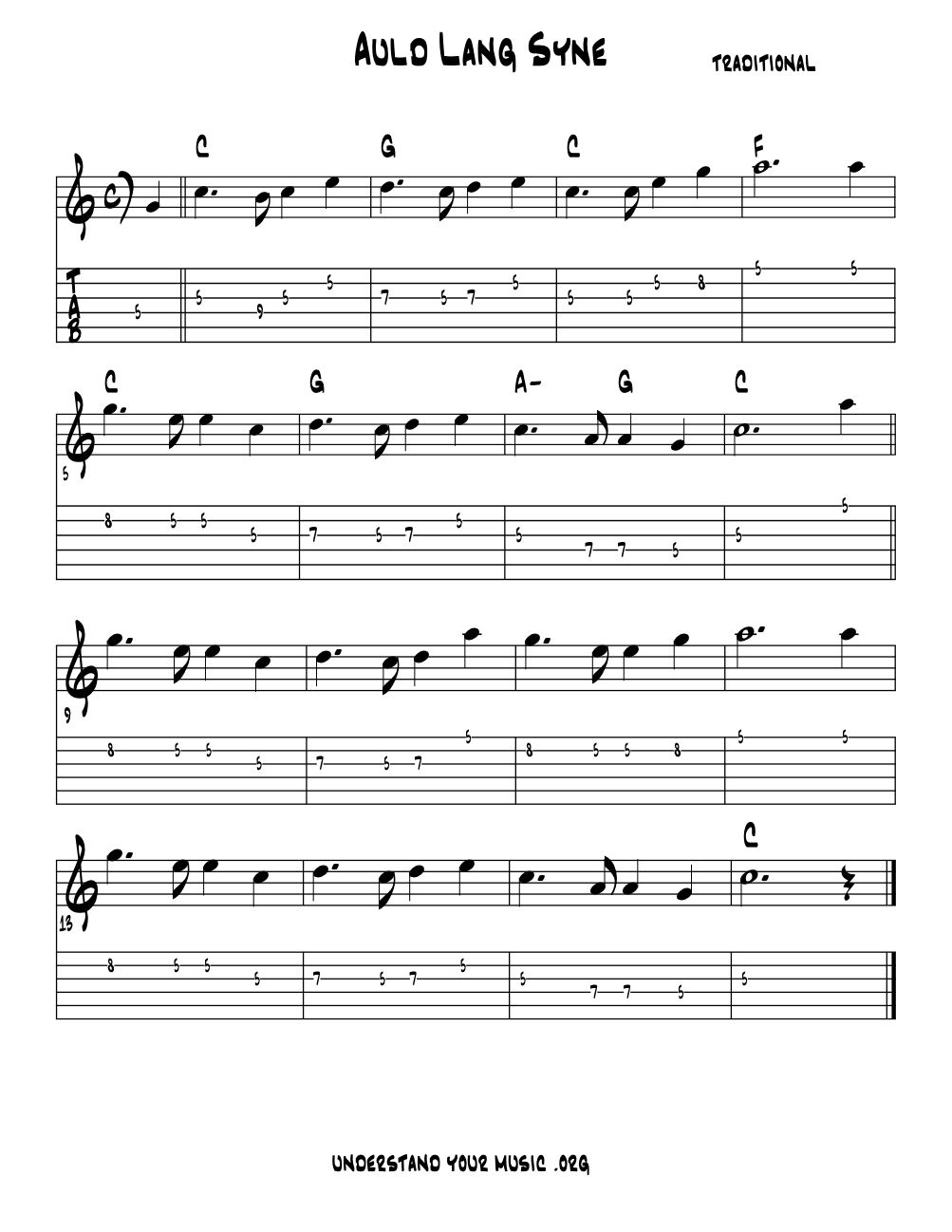 |
'Got anything for New Year's yet?' |
"Arkansas Traveler." In the following arrangement of pure American melody we brighten up the tempo to near 200, transitioning us stylewise towards the bluegrass side of country. So tempo determines style too? Yep. Takes real chops to play fast and this just limits a lot of players. Regardless, we all need one up tempo chop buster number and here it is :) |
|
As jaunty a riff as any, a longer stream of 1/8th notes in bar nine once repeated, is a nice counter theme to the opening line. Here written in 16 bars and A / B melodic form, the two themes are completely organic to one another in that classic folksy 'call ~ response', or 'antecedent ~ consequent' or even 'theme ~ variations' style of phrasing. So, scooting right along in 'C' major at about 190. Example 41. |
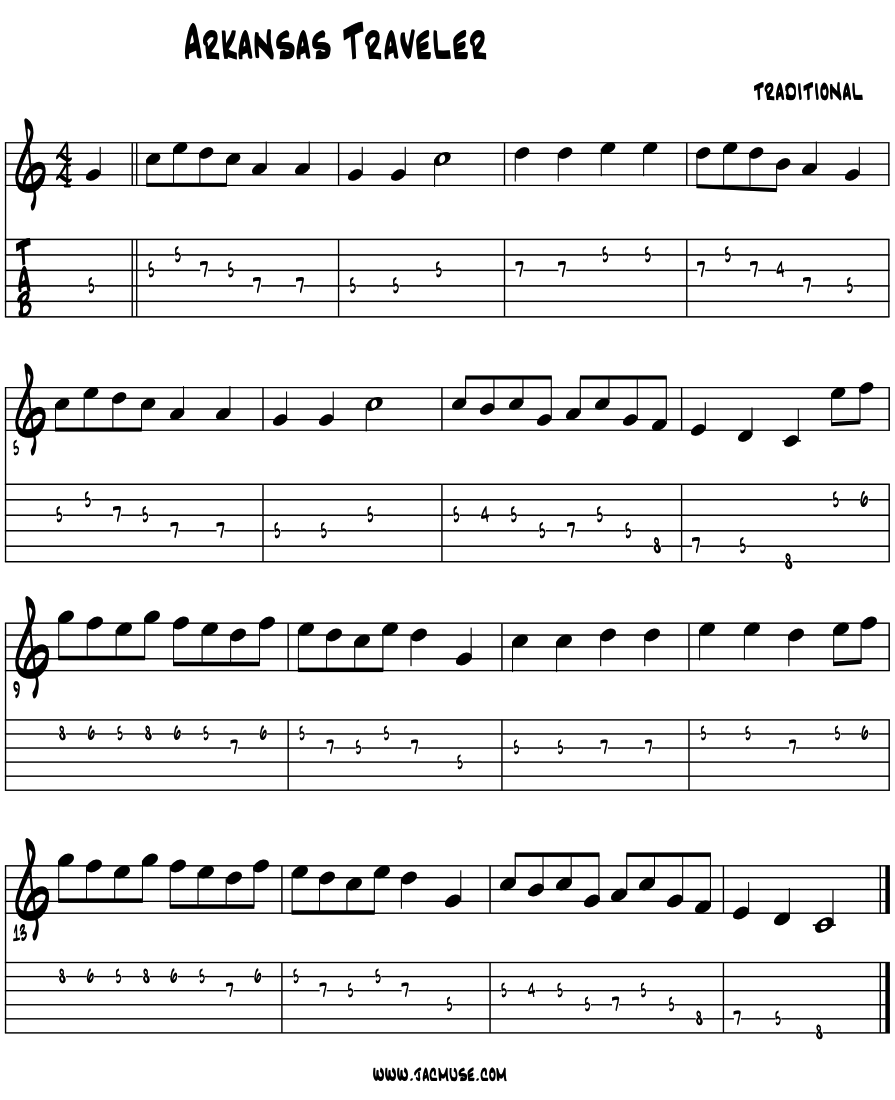 |
"America, The Beautiful." Our penultimate melody to include could easily have been at the top of the list here. I wonder if this was a fave of Coltrane, what with all the half and whole note rhythms in the melody. Probably. Very poignant, earnest and near perfect diatonic and there's an octave leap. Winner ! Do learn it here if need be. Using the open strings this time. Example 42. |
|
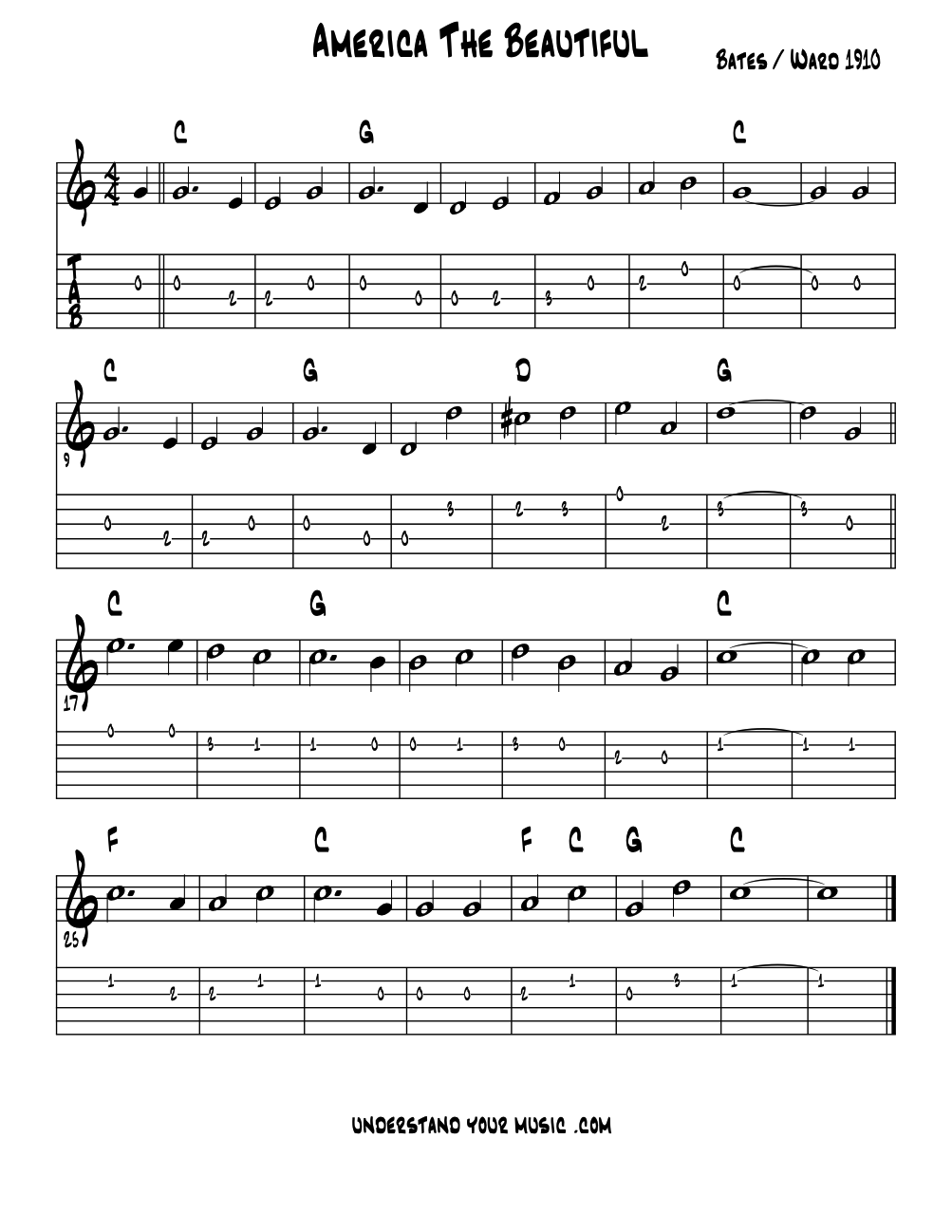 |
Four chords and the truth ? Yea, pretty much :) |
"The Star Spangled Banner." Our final melody to include could easily have been at the top of the list; our own Americana national anthem. Major scale and surely major triad based, its melody moves just one time beyond the diatonic realm, finding the raised Four (#4) to Five melodic motion in the first phrase. |
|
A solid 32 bar song form and structure, four / eight bar phrases combine to create a passionate story and all in all a well crafted song that truly inspires. Of all of the songs included here, the "Star Spangled Banner" offers a fairly challenging line pitchwise with some historical phrasing ideas that will strengthen our own interpretive powers, once the pitches and rhythms are solidly under our fingers. Learn it here if need be. Give it a click and hum along to get started, easy to find the words :) Thinking in 'C' major. Example 43. |
 |
Nice song yes ? Yea a big challenge too. Add in a performance at one of the many events that opens up with the national anthem, and yea we've a start to finish curriculum for putting together a challenging song all the while knowing that at some point we'll get to perform it in a very focused, very public, to create a very 'gonna bare the soul' moment. |
About the #4. This measured tritone from our tonic root pitch, an 'F#' in 'C', is the diatonic initiator of V of V. Once broached it really is click by click around the cycle and we discover the additional Five of Five's that enhances the pitches beyond their diatonic boundaries without legit sorts of modulation to new key centers. Isn't this backpedaling ? |
Warming up. Any who plays sports know the value of warming up their strengths prior to taking the field. Same for musicians right ? In doing so we; breathe :) Connect mind and body into hearts and hands. Playing chord cycles / playing lines through changes Simple melodies through 12 keys. From the melodies, find and create patterns, shapes and eight note licks from the mostly quarter note, big 4. Find unique cycles of things / chop builders from a totally melodic context. So we learn theme and variations and develop the strength to improvise melody. That's the goal, that our improvised lines tell a story similar to that of the written melody of the song. |
"If." Two letters that often get to carry just a ton of coolness ... so ... 'if we can get a couple of pitches of one song to really really swing, then you'll know it, and always own it to freely share forever. |
Review. Were you able to find a melody or two to rote learn in the basic scale shape fingering suggested? Sense that once the pitches of a scale shape are under our fingers, that a melody is just a thought or two away? Cool, for that's the crux of this page; find a melody we deeply know in our hearts, find the pitches on our instruments, then simply work it over and over to strengthen our ability to impart our emotional and artistic ideas into the pitches of its melody. This is the basic physical / intellectual musical connectivity that founds our own unique improvisations, creative expressions to develop our artistic signature. |
Why learn melodies / themes? From the old as the hills artistic technique often termed 'a theme and its variations', an artistic concept and philosophy which also applies to many of our art disciplines; musics, sculpting, painting, writing etc., this theme and variations is the basis of so much of what American improv is about, where the music being performed is played by ear. That traditionally our musics are not being read as notation from charts as they are being performed. |
Through folk and into the blues, onto the various rocks, countries and myriad of pop stylings, once the theme is stated, soloists often get to 'variate' and create their own 'take' of the melody. When happening in real time with spontaneous or already worked out ideas, most is played by ear and improv is happening. |
Jazz players often get a further valence for exploration here in that the chord progression of the song provides a second vehicle for the improv. Artists will 'spell' the pitches of each chord into melodic lines. That each of the chords can become a 'mini theme' of their own, offering a something to variate. Historically, arpeggios have played an oversized role in this approach to the improv. Mix in chord substitution here, a common occurrence in jazz performance, and we can end up with a ton of resource to choose from in creating our play by ear variations. |
Another important aspect of this 'play by ear' discussion is about rhythms and specifically developing one's own ability to swing. In the following method, we look to some historically deep Americana melodies, some that might take us back to our childhoods, for melodies that we might already intuitively know by heart and rote. Once under our fingers, we've then got the necessary ingredients to work on its timing and to get the line to swing. The idea here is that by getting one of these phrases truly 'up off the ground' and swinging, we've connected the inner dots of swing between our heads, hearts and hands and can then apply this magic of time and space to whatever might come along. |
So what follows are a dozen or so melody lines that are suggested to be played by ear to figured out, then committed to rote memory. Once there by rote, our individual interpretations begin anew. And though we might not ever gig these sorts of lines depending on our own artistic directions, in practice they'll strengthen our melodic confidence to interpret melodies and project the emotional statement we're looking to make. |
References. References for this page's information comes from school, books and the bandstand and made way easier by the folks along the way. |
Find a mentor / e-book / academia Alaska. Always good to have a mentor when learning about things new to us. And with music and its magics, nice to have a friend or two ask questions and collaborate with. Seek and ye shall find. Local high schools, libraries, friends and family, musicians in your home town ... just ask around, someone will know someone who knows someone about music and can help you with your studies in the musical arts. |
|
Always keep in mind that all along life's journey there will be folks to help us and also folks we can help ... for we are not in this endeavor alone :) The now ancient natural truth is that we each are responsible for our own education. Positive answer this always 'to live by' question; 'who is responsible for your education ... ? |
Intensive tutoring. Luckily for musical artists like us, the learning dip of the 'covid years' can vanish quickly with intensive tutoring. For all disciplines; including all the sciences and the 'hands on' trade schools, that with tutoring, learning blossoms to 'catch us up.' In music ? The 'theory' of making musical art is built with just the 12 unique pitches, so easy to master with mentorship. And in 'practice ?' Luckily old school, the foundation that 'all responsibility for self betterment is ours alone.' Which in music, and same for all the arts, means to do what we really love to do ... to make music :) |
 |
"These books, and your capacity to understand them, are just the same in all places. Always bear in mind that your own resolution to succeed, is more important than any other one thing." |
|
Academia references of Alaska. And when you need university level answers to your questions and musings, and especially if you are considering a career in music and looking to continue your formal studies, begin to e-reach out to the Alaska University Music Campus communities and begin a dialogue with some of Alaska's finest resident maestros ! |
|
